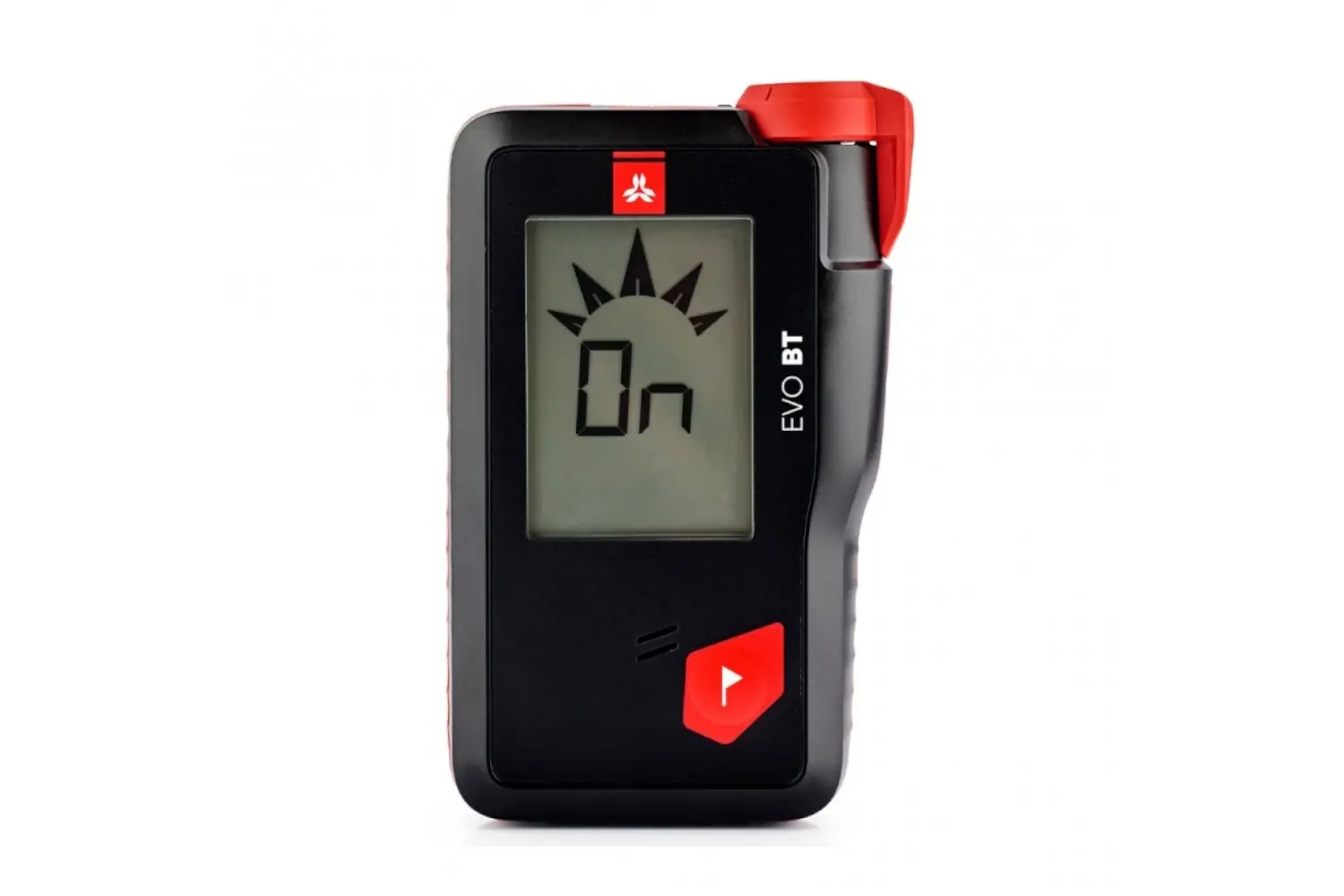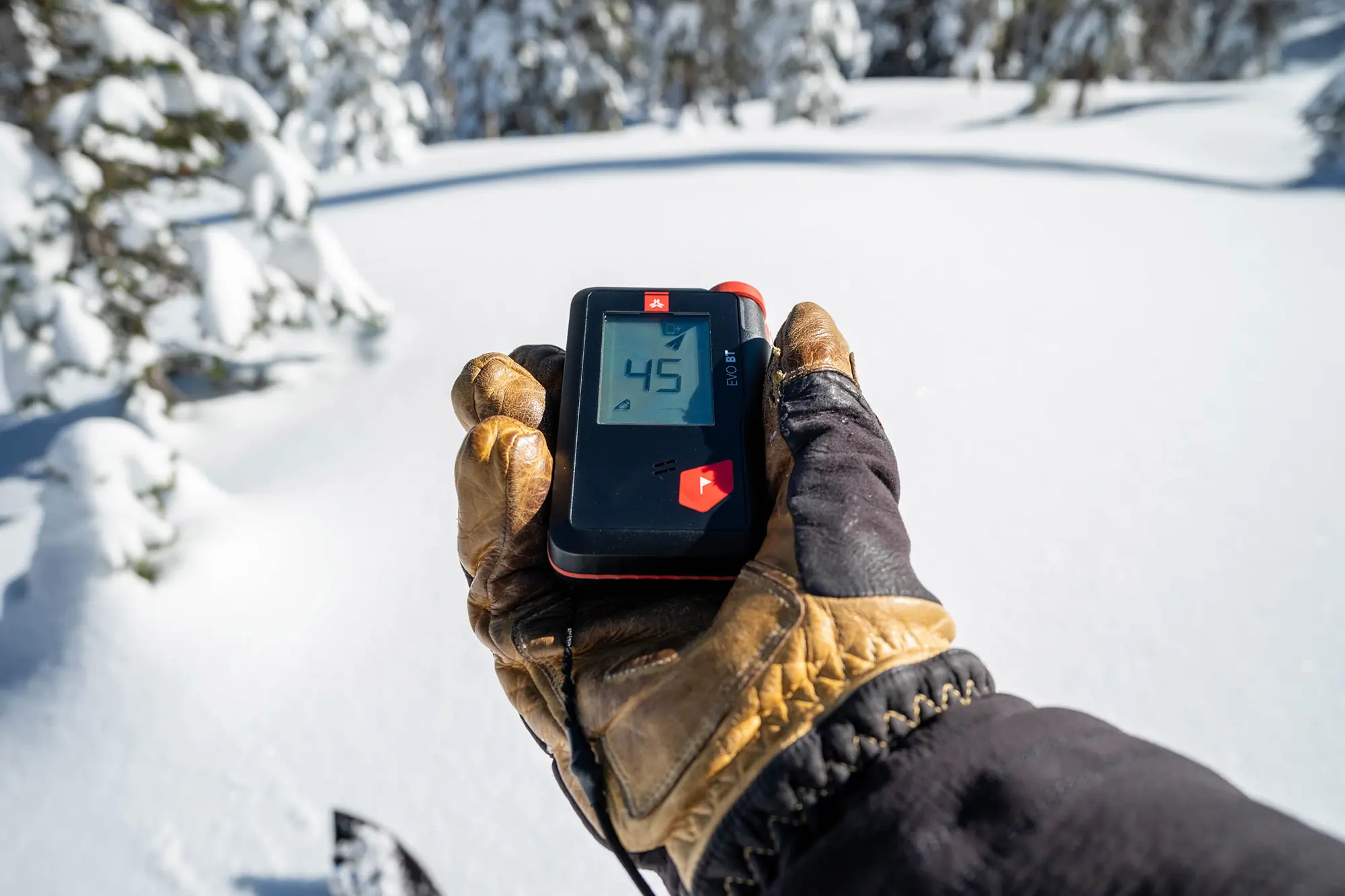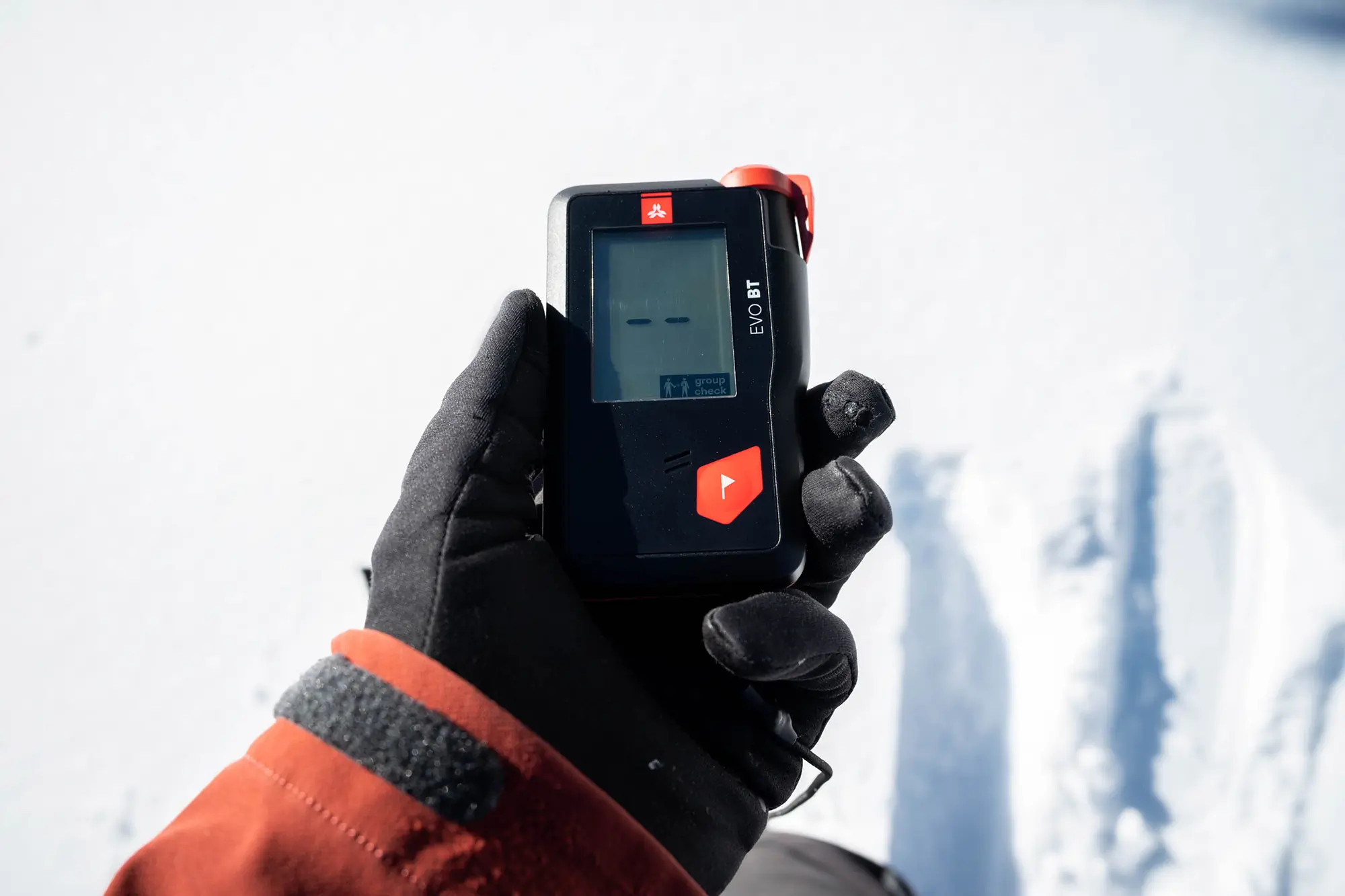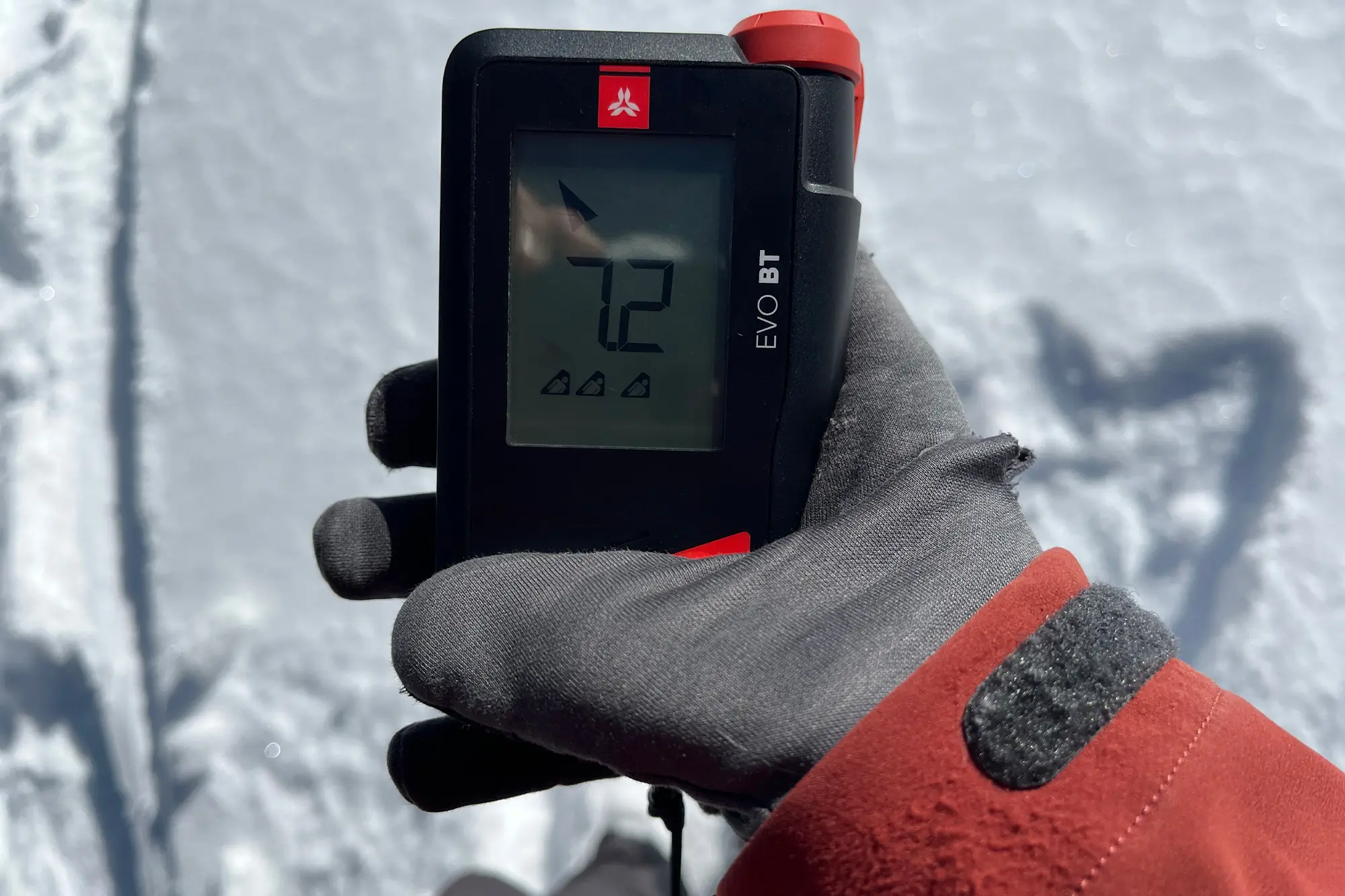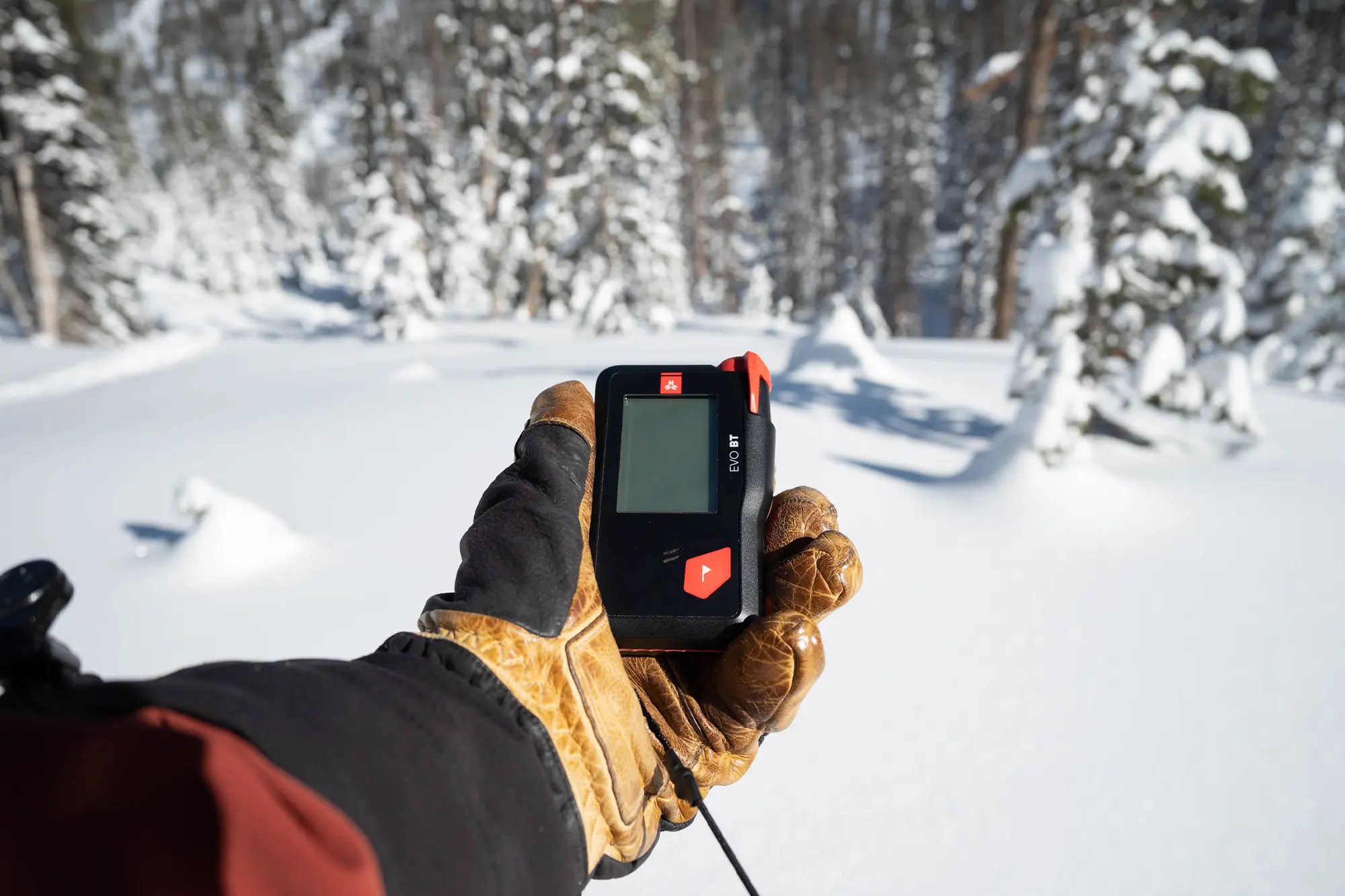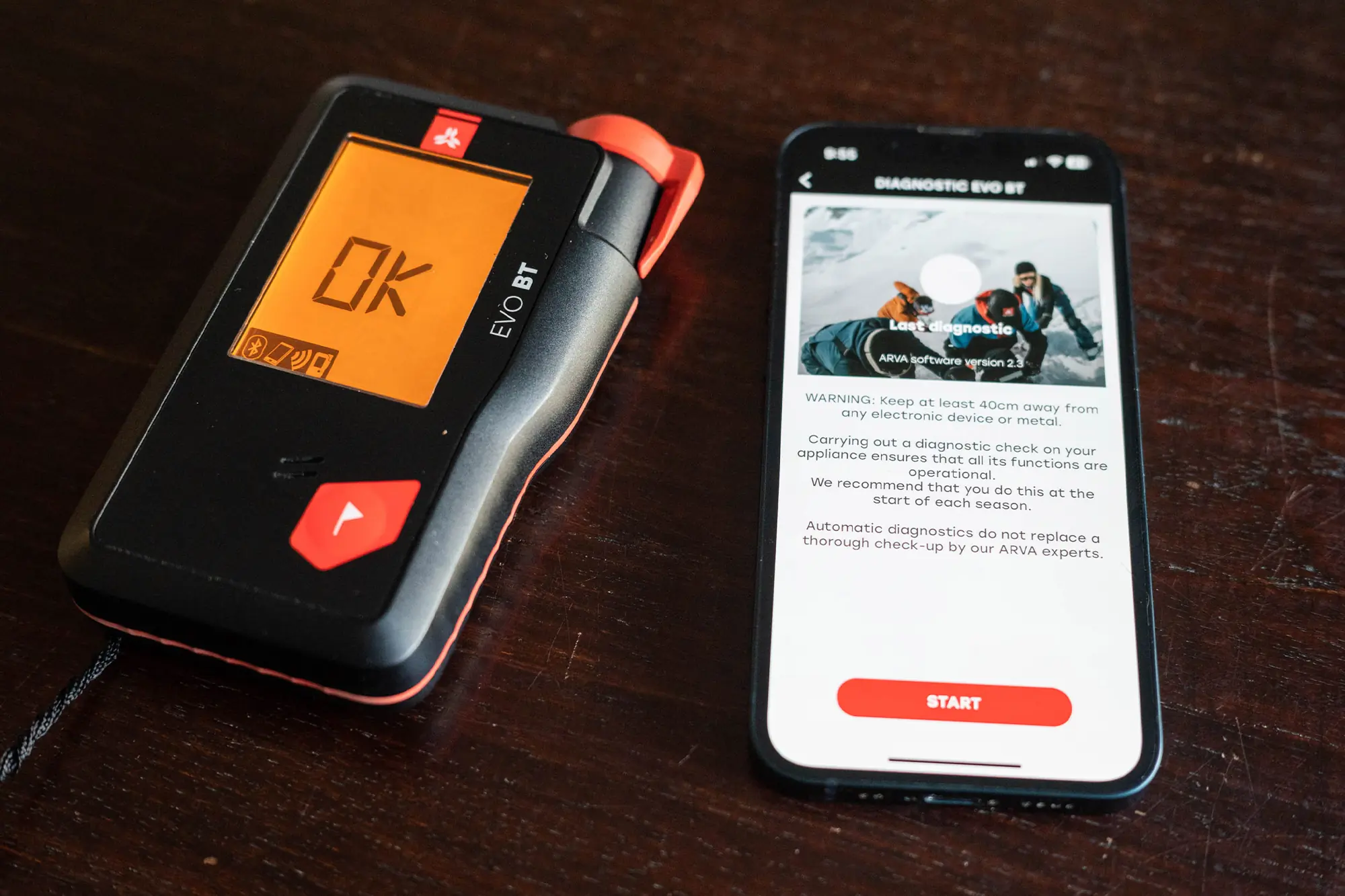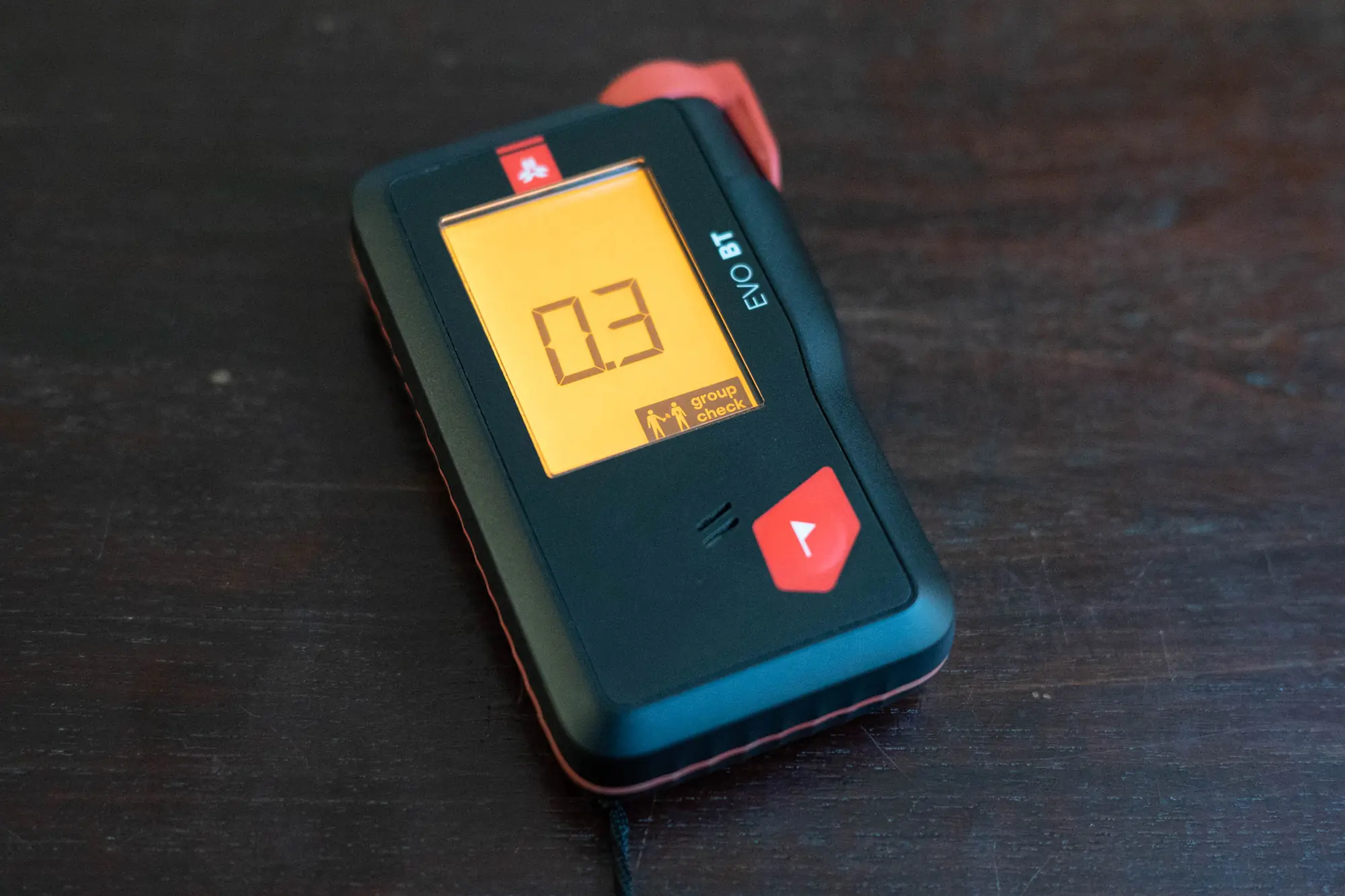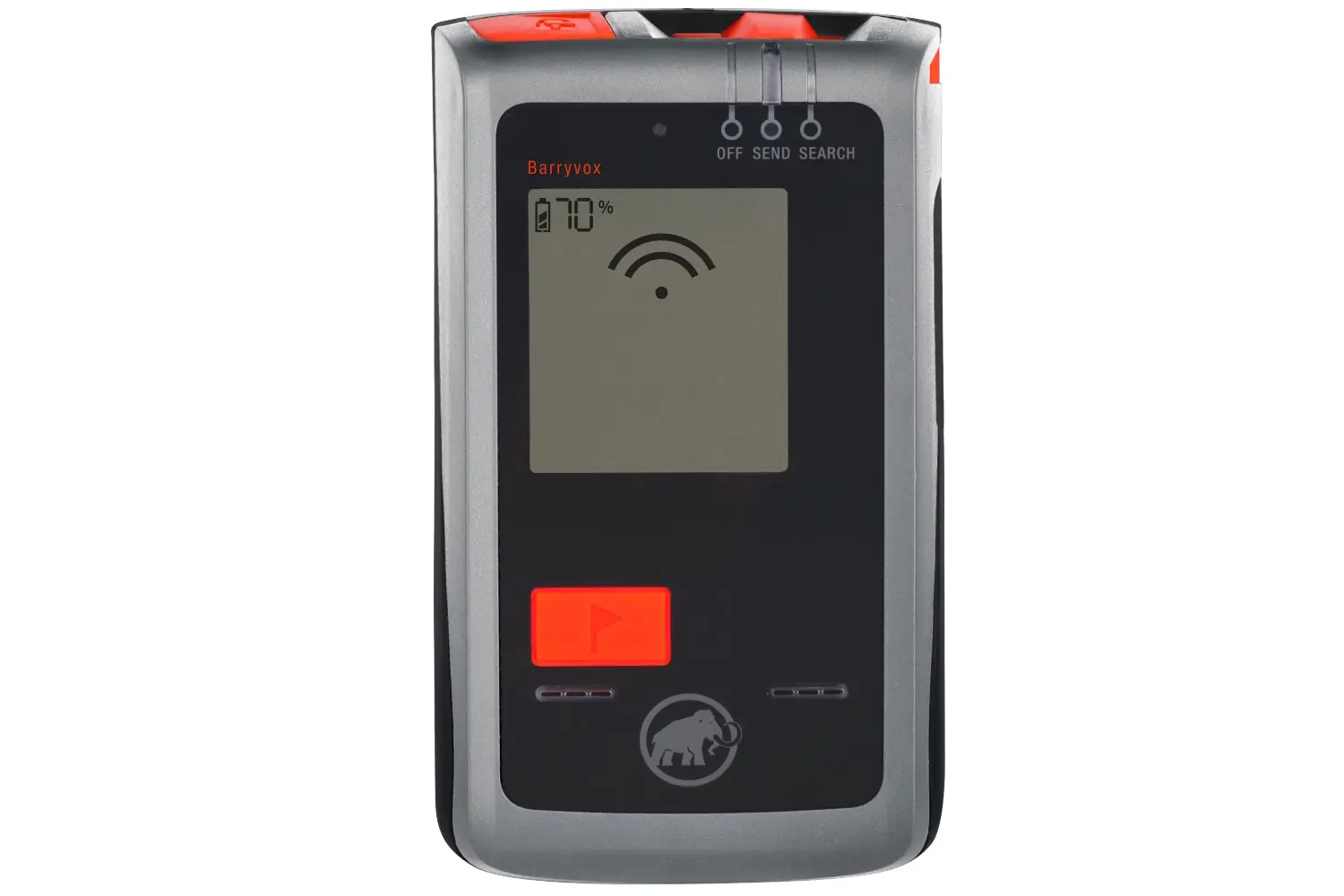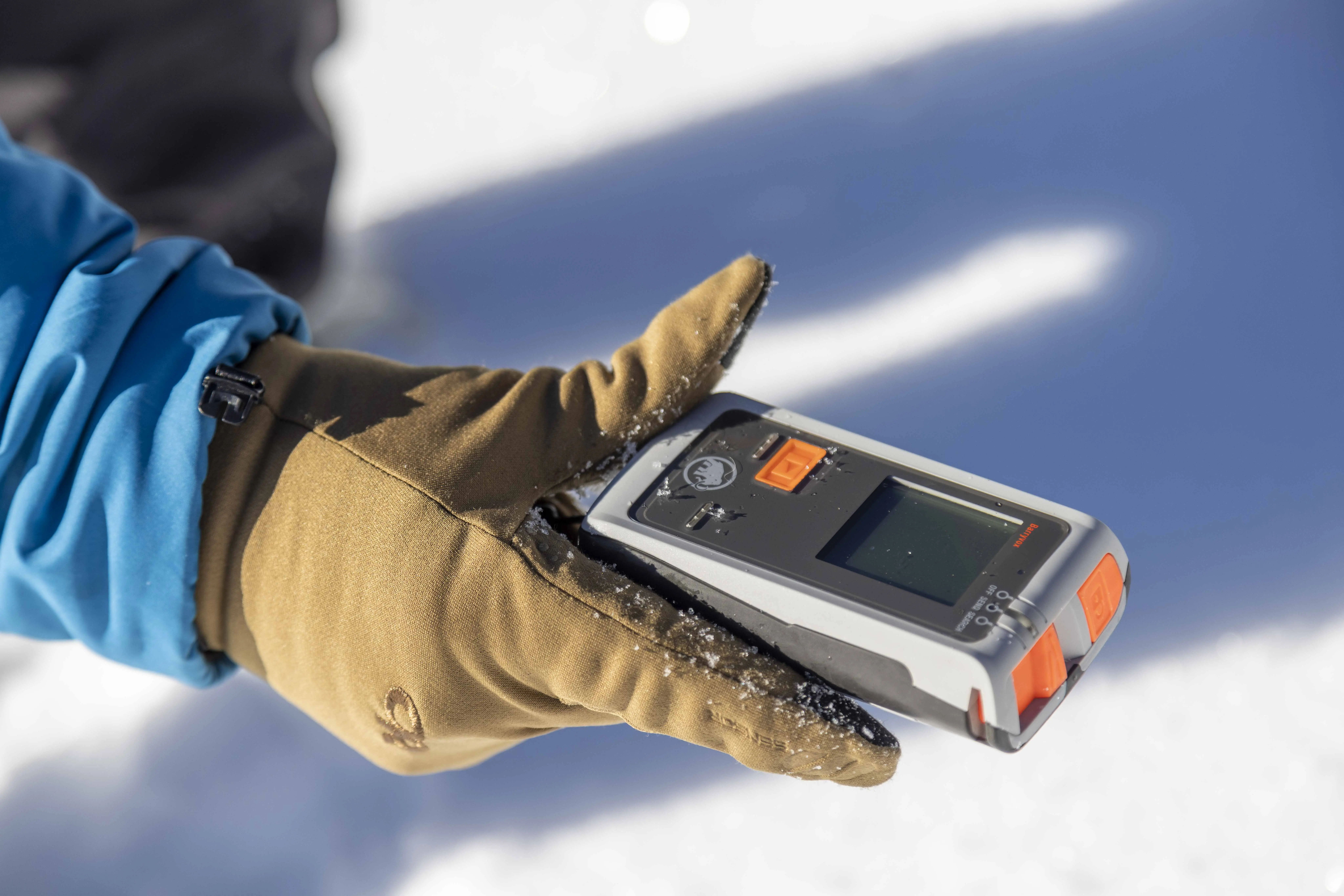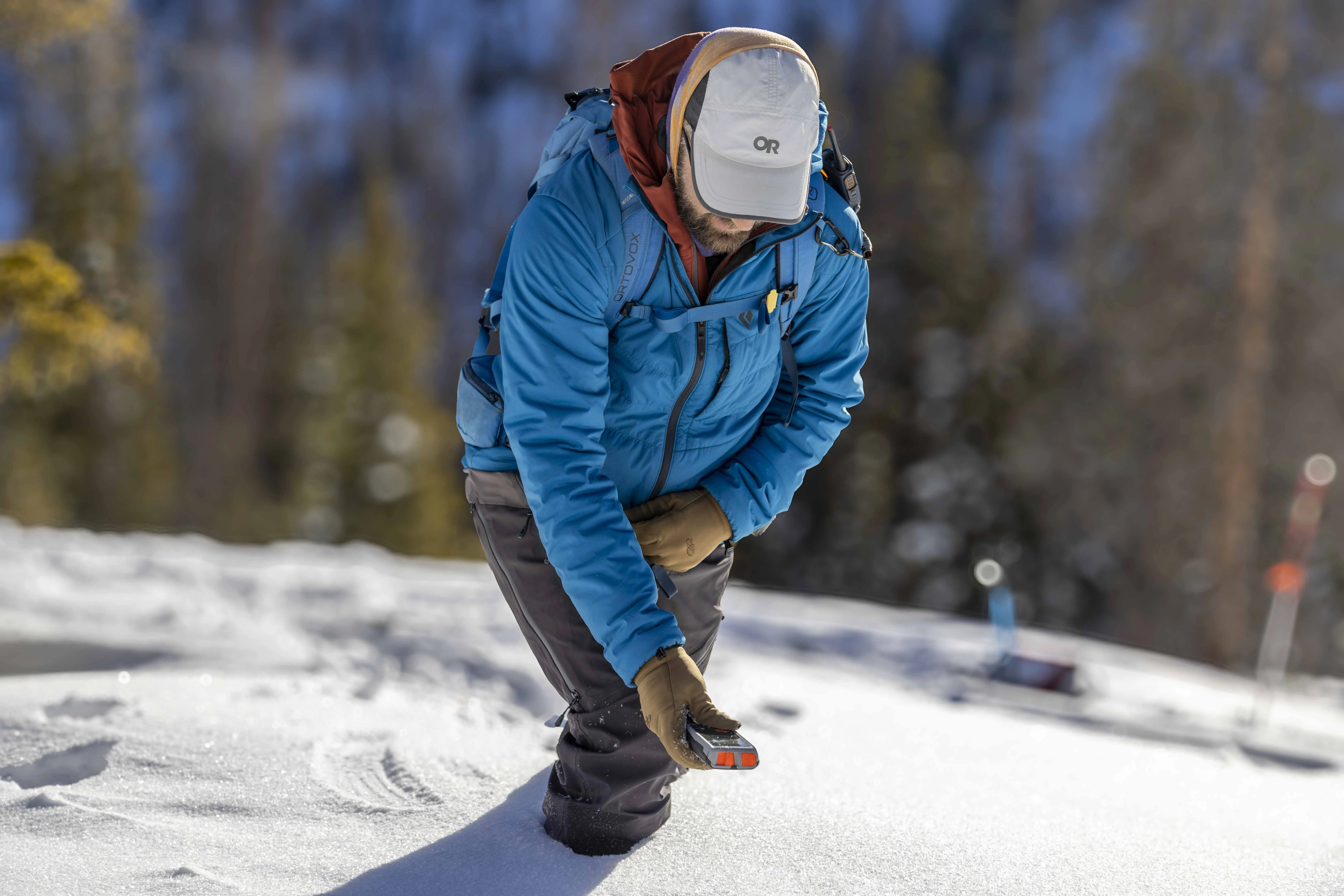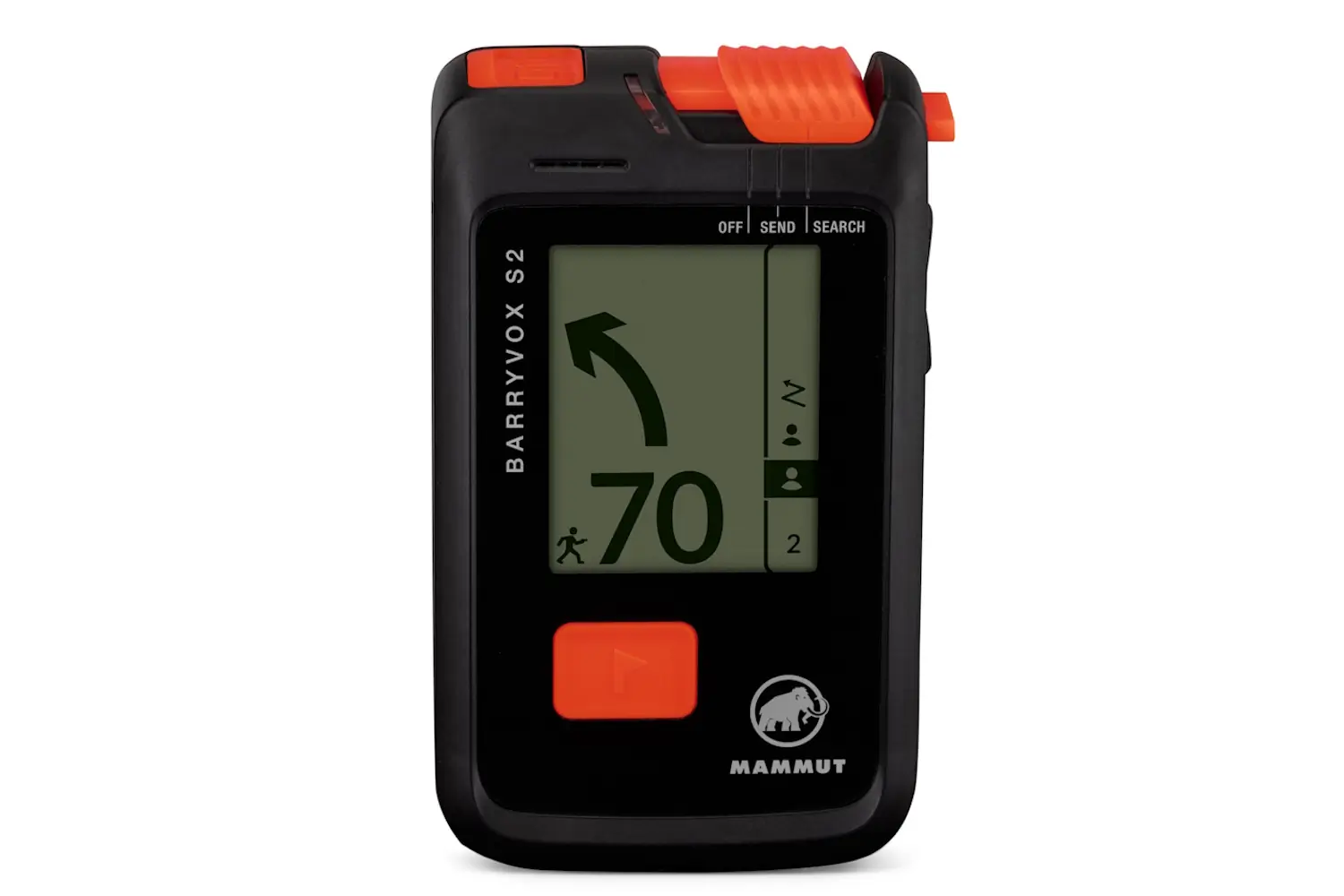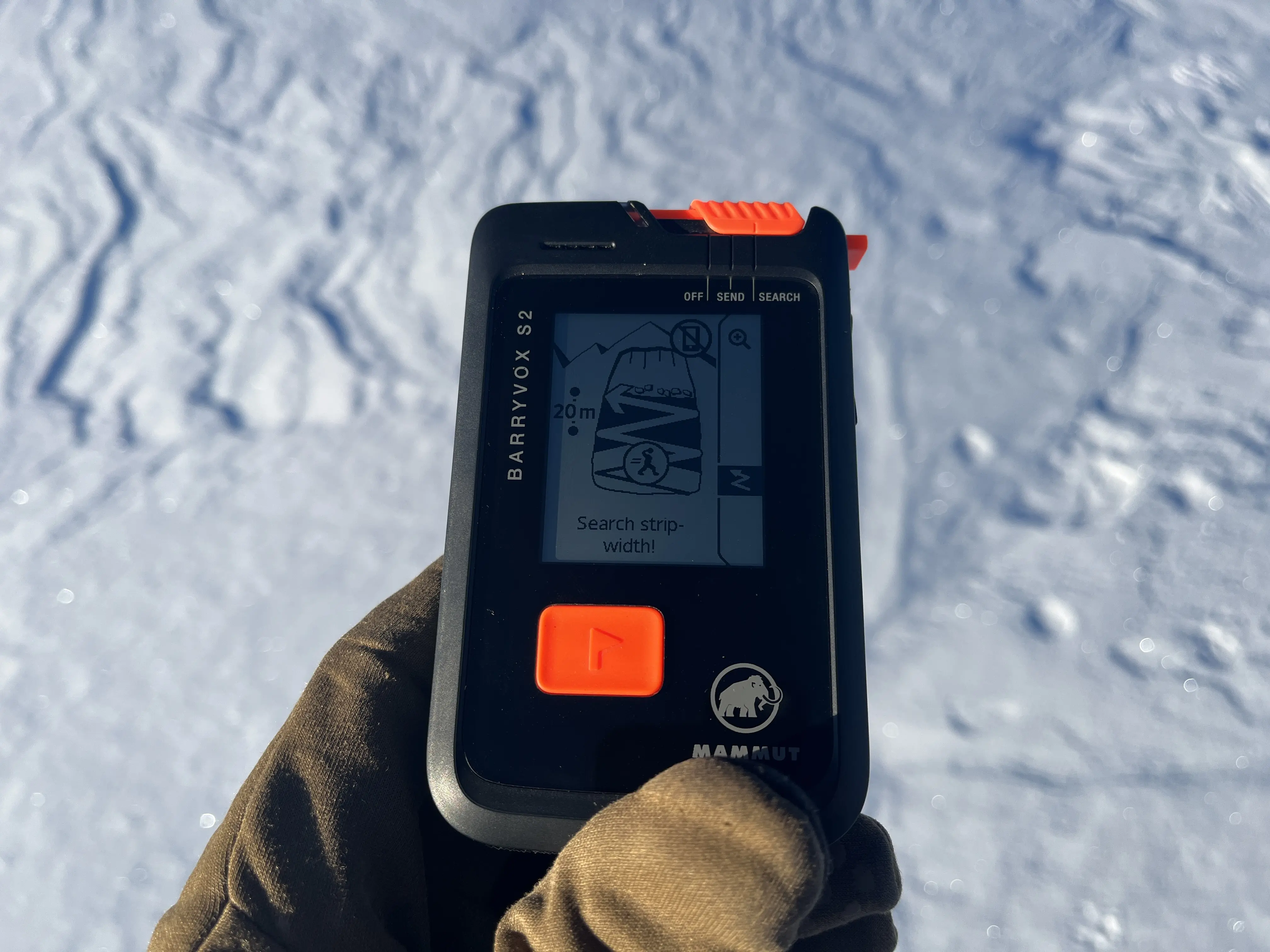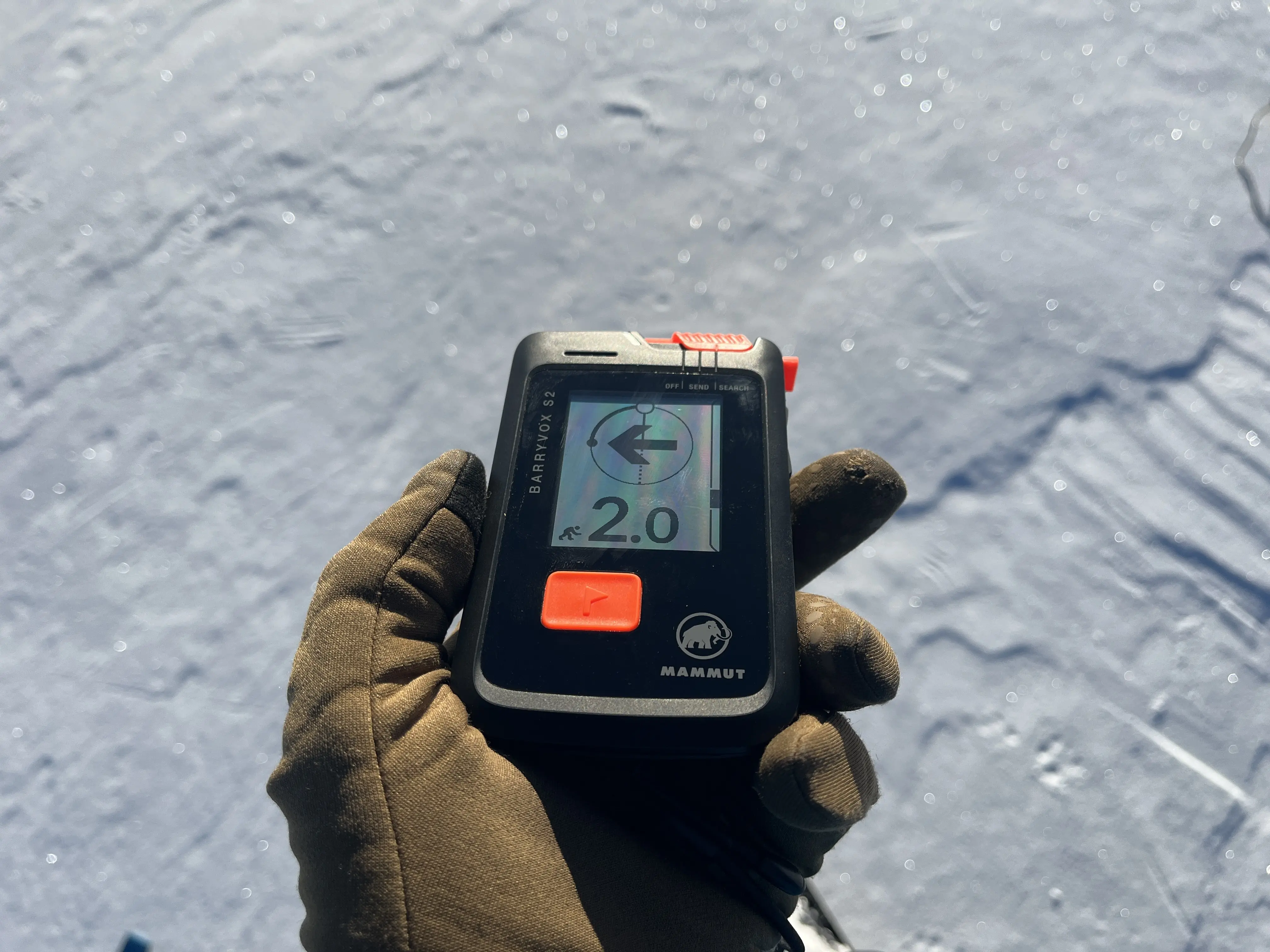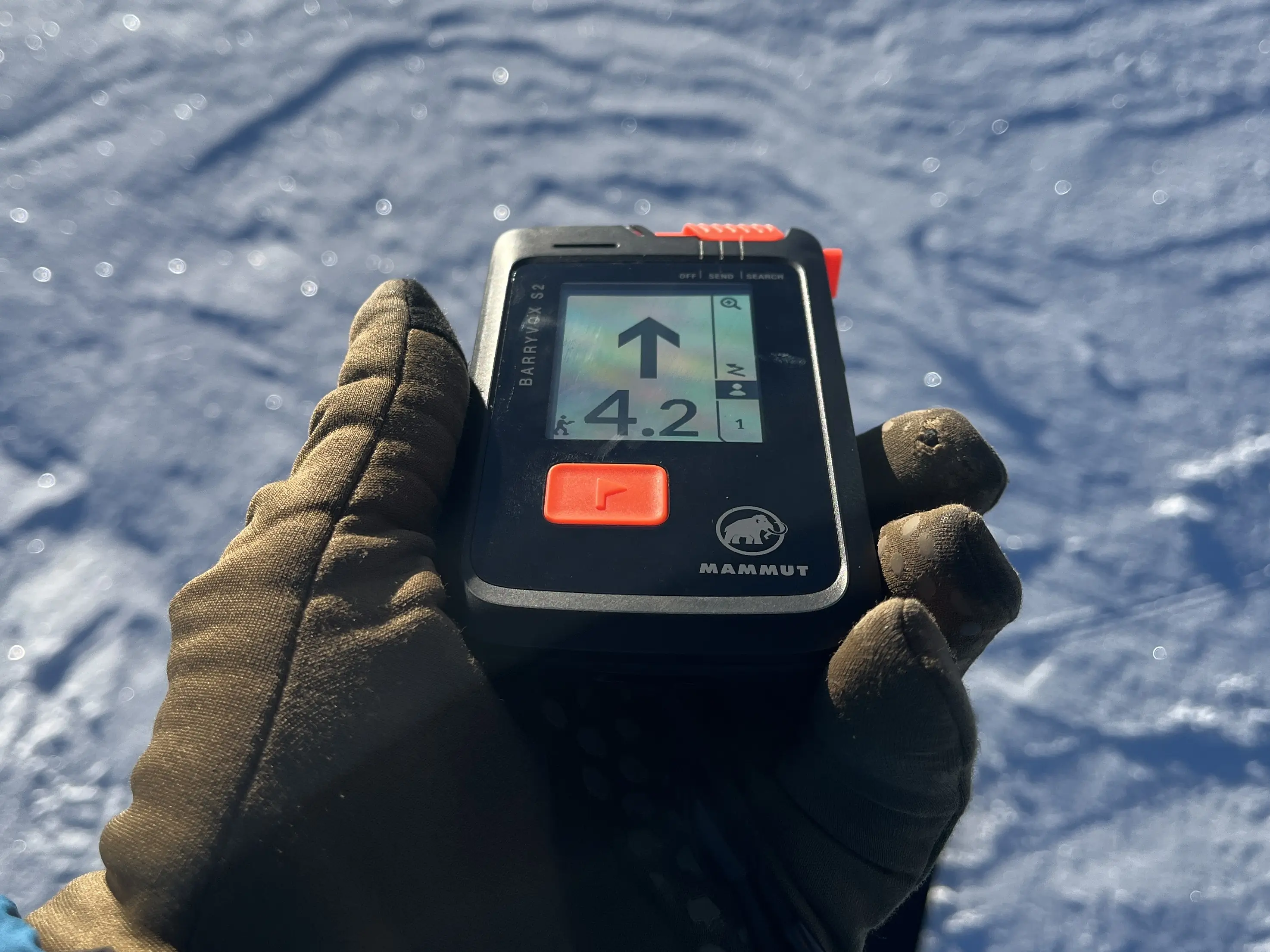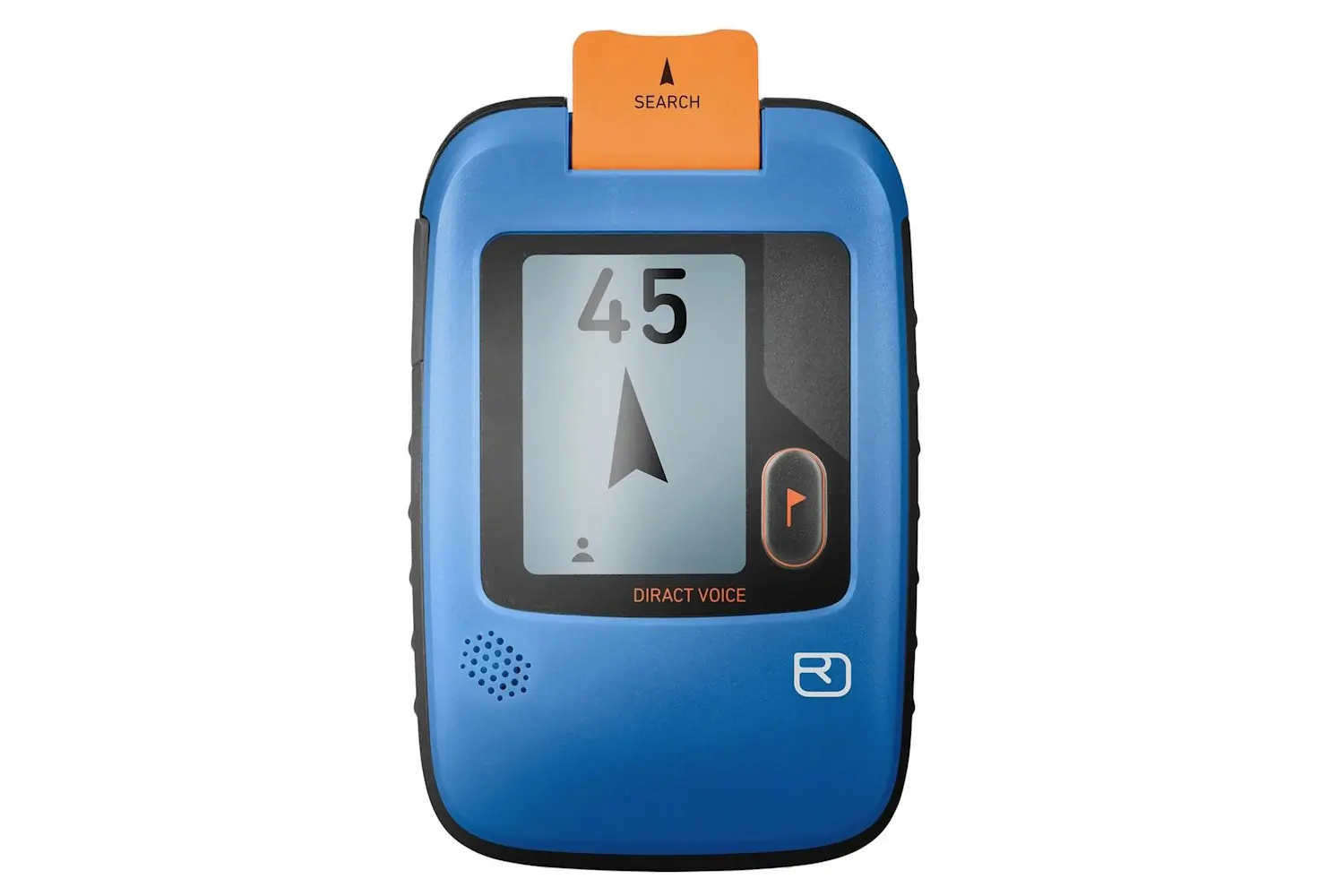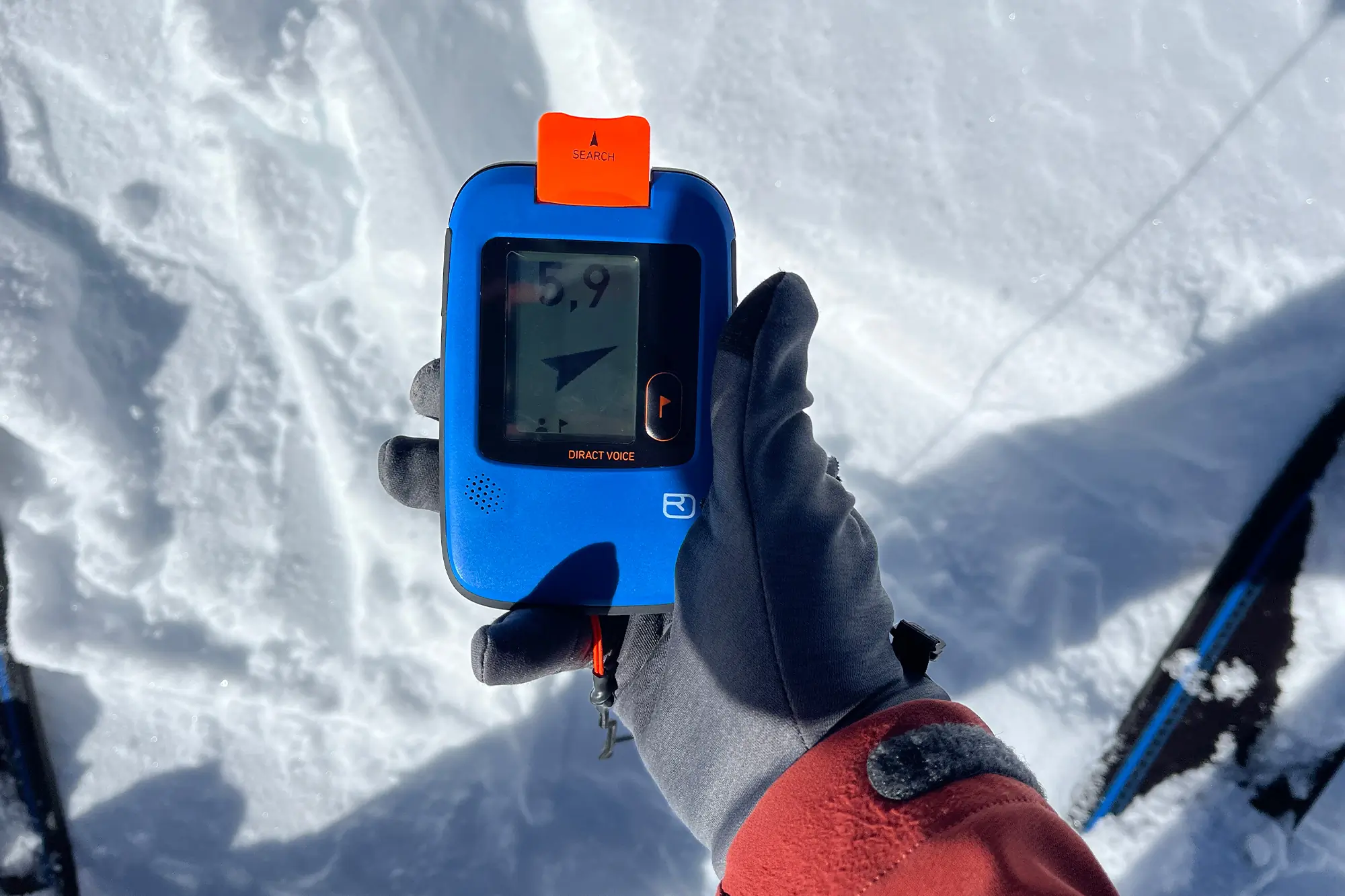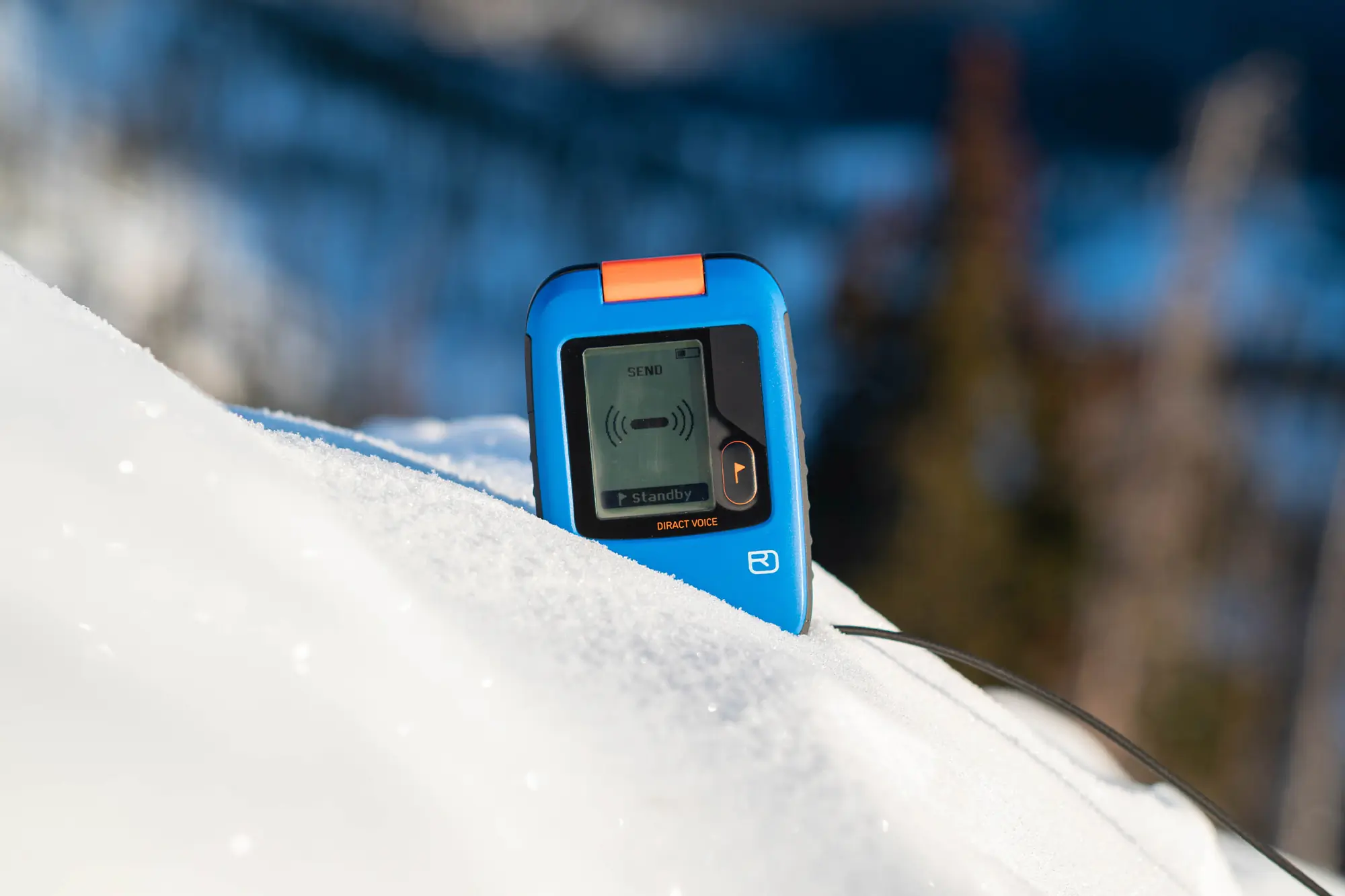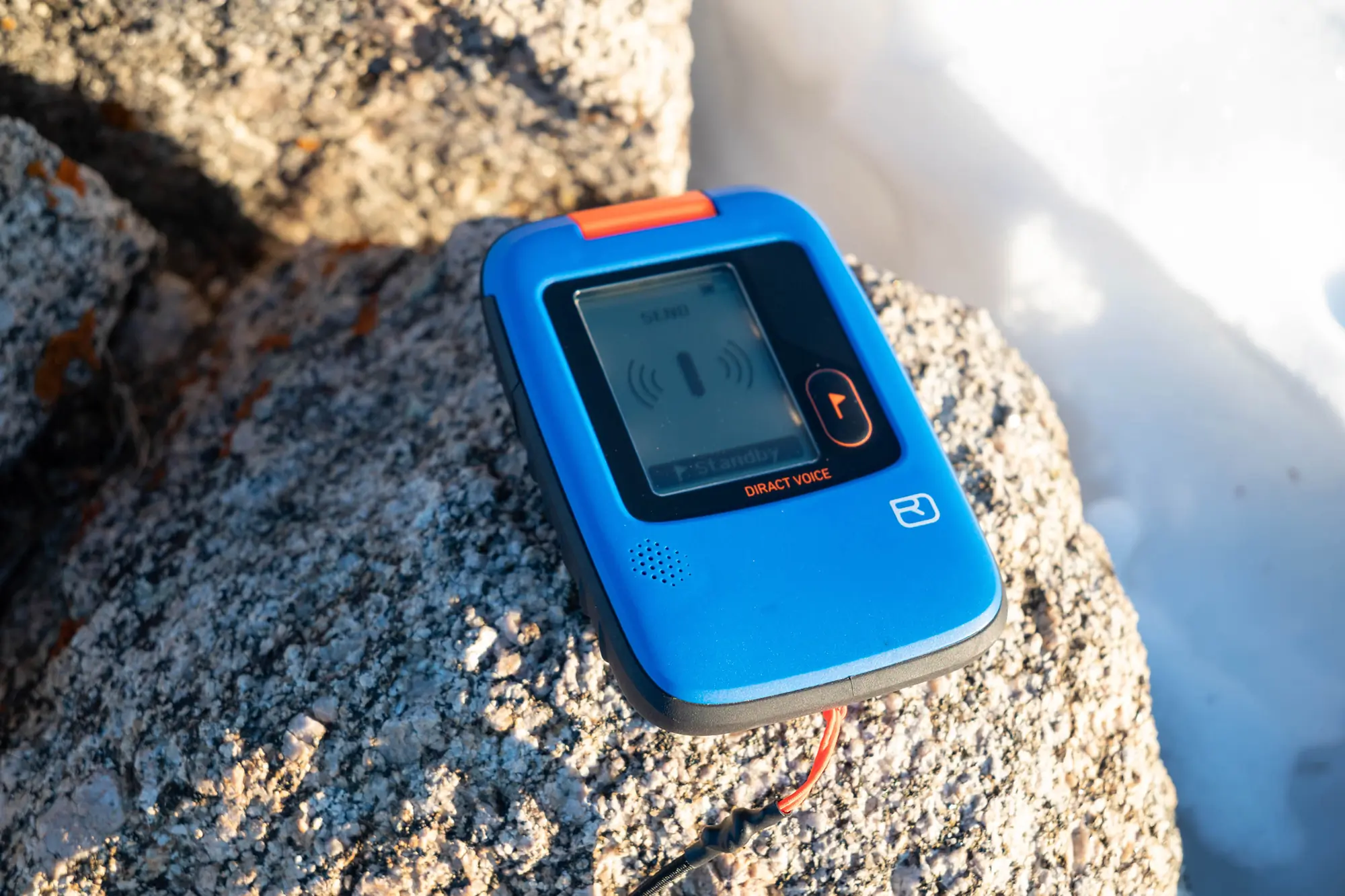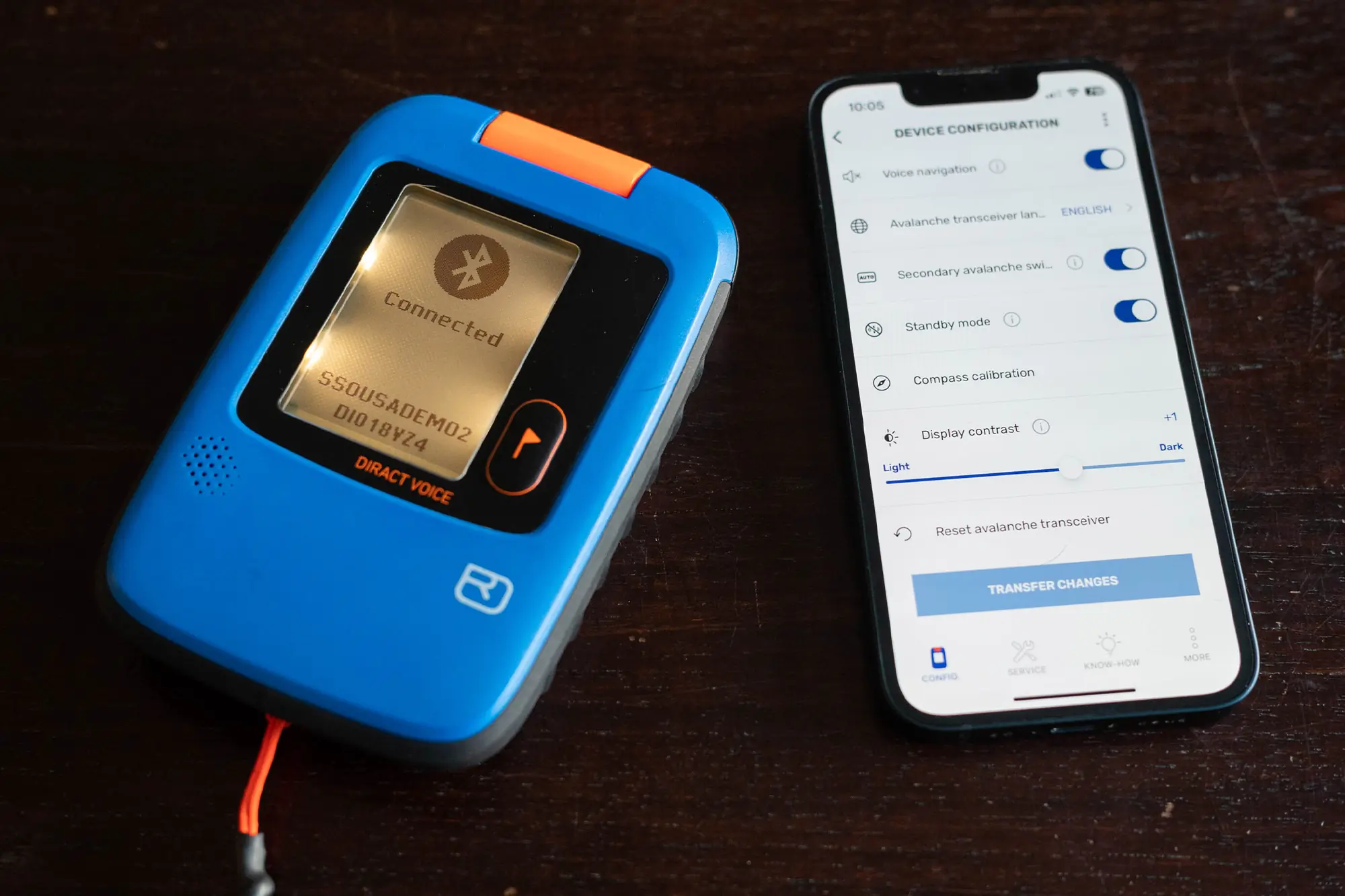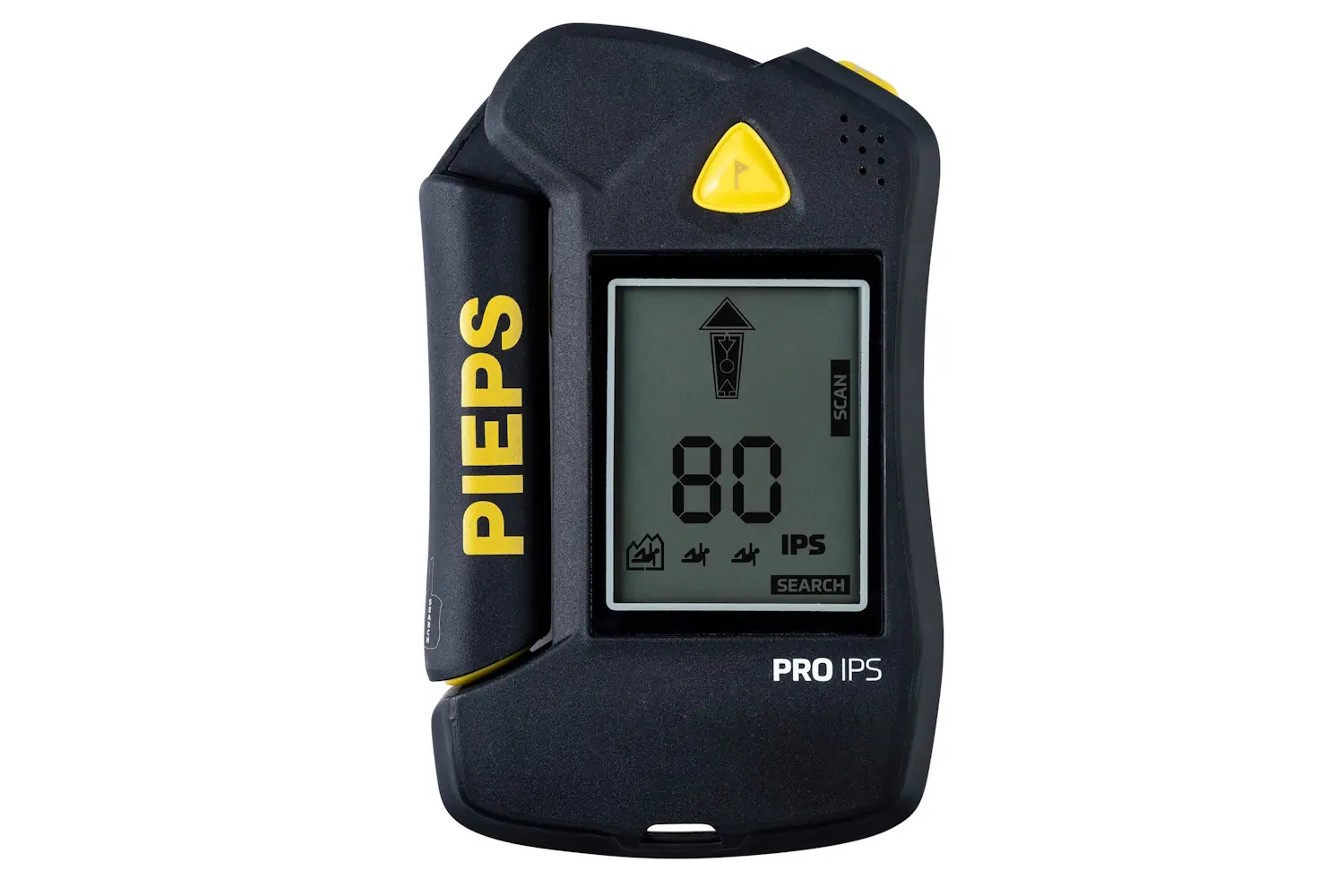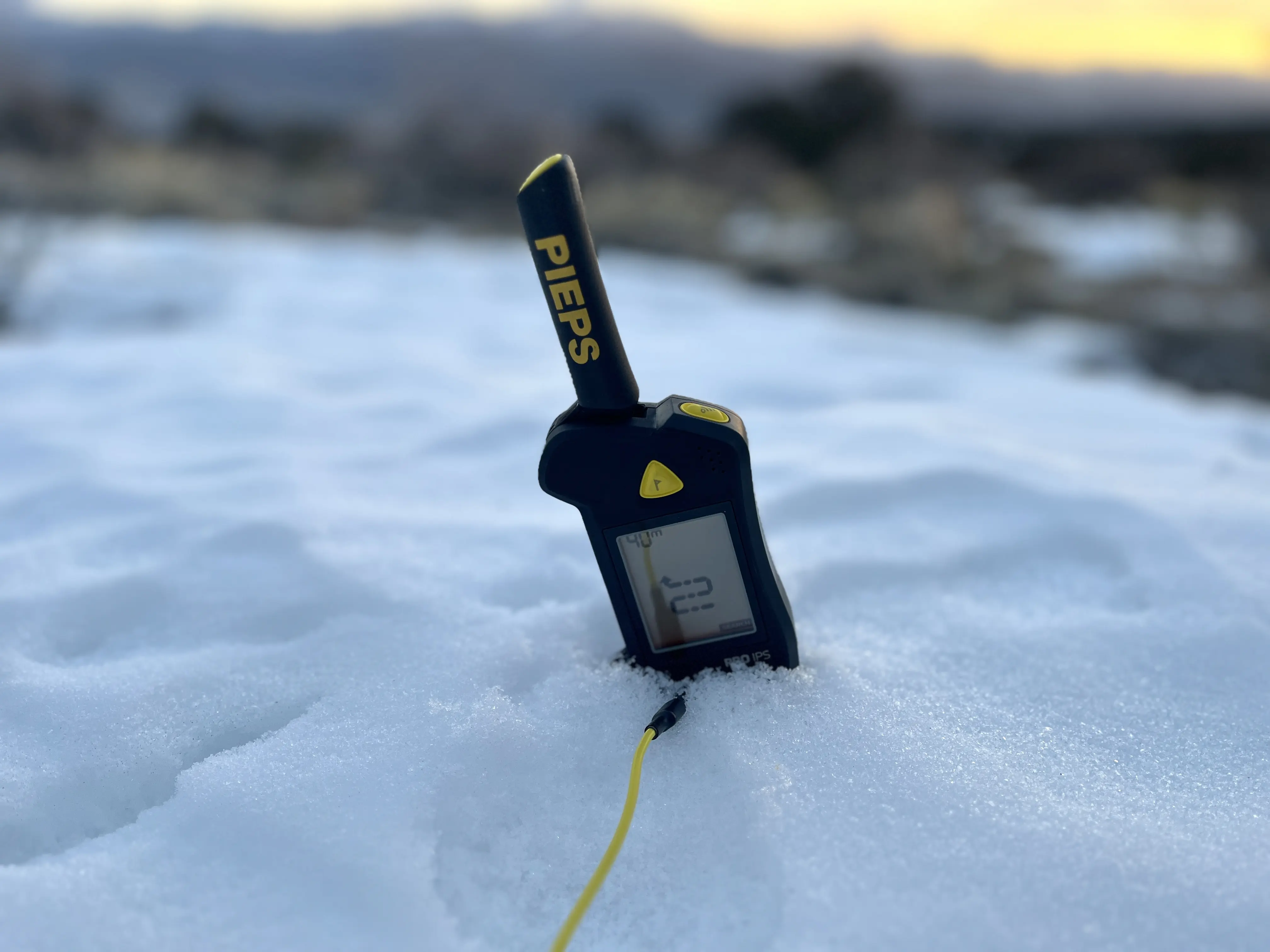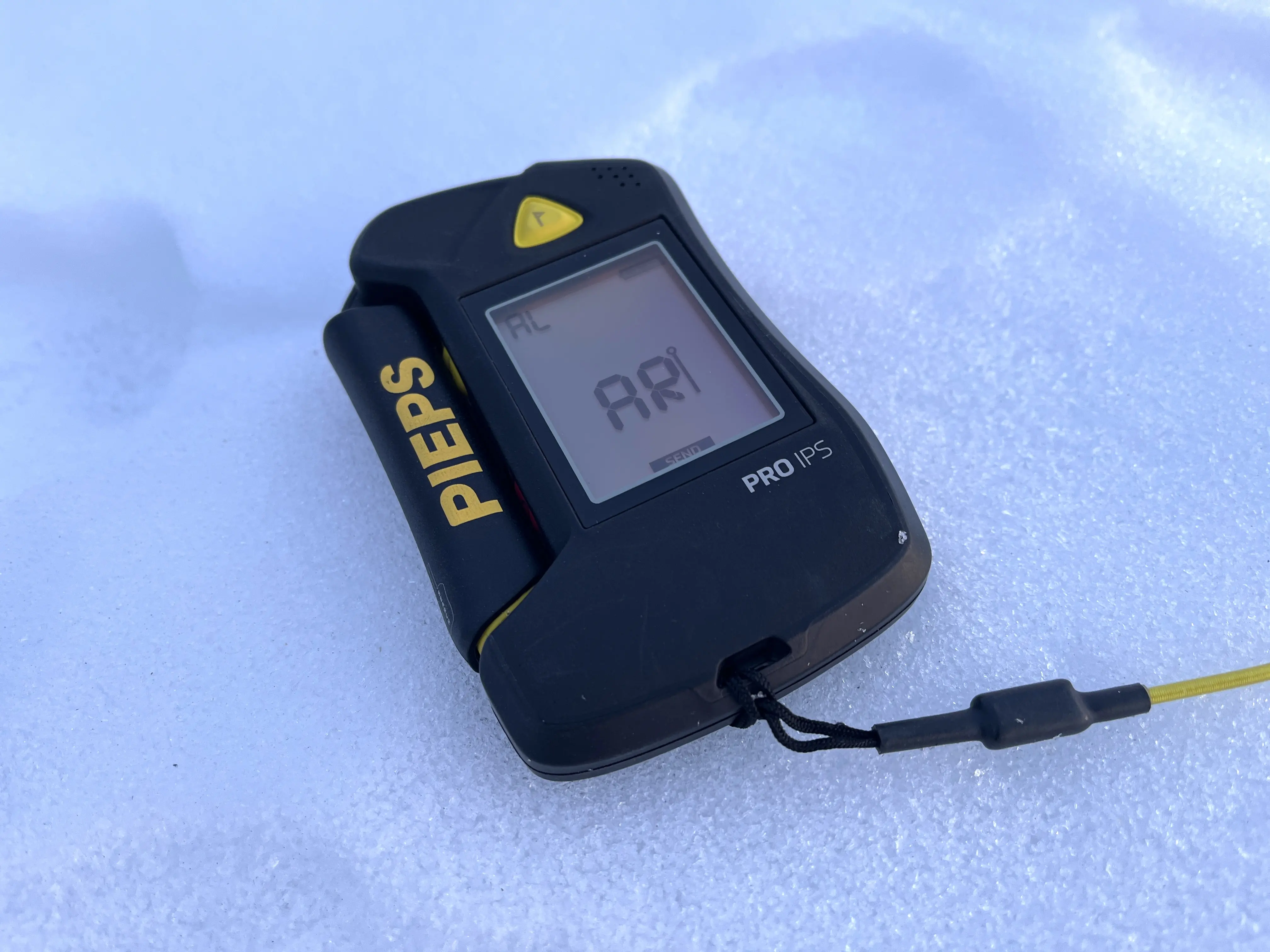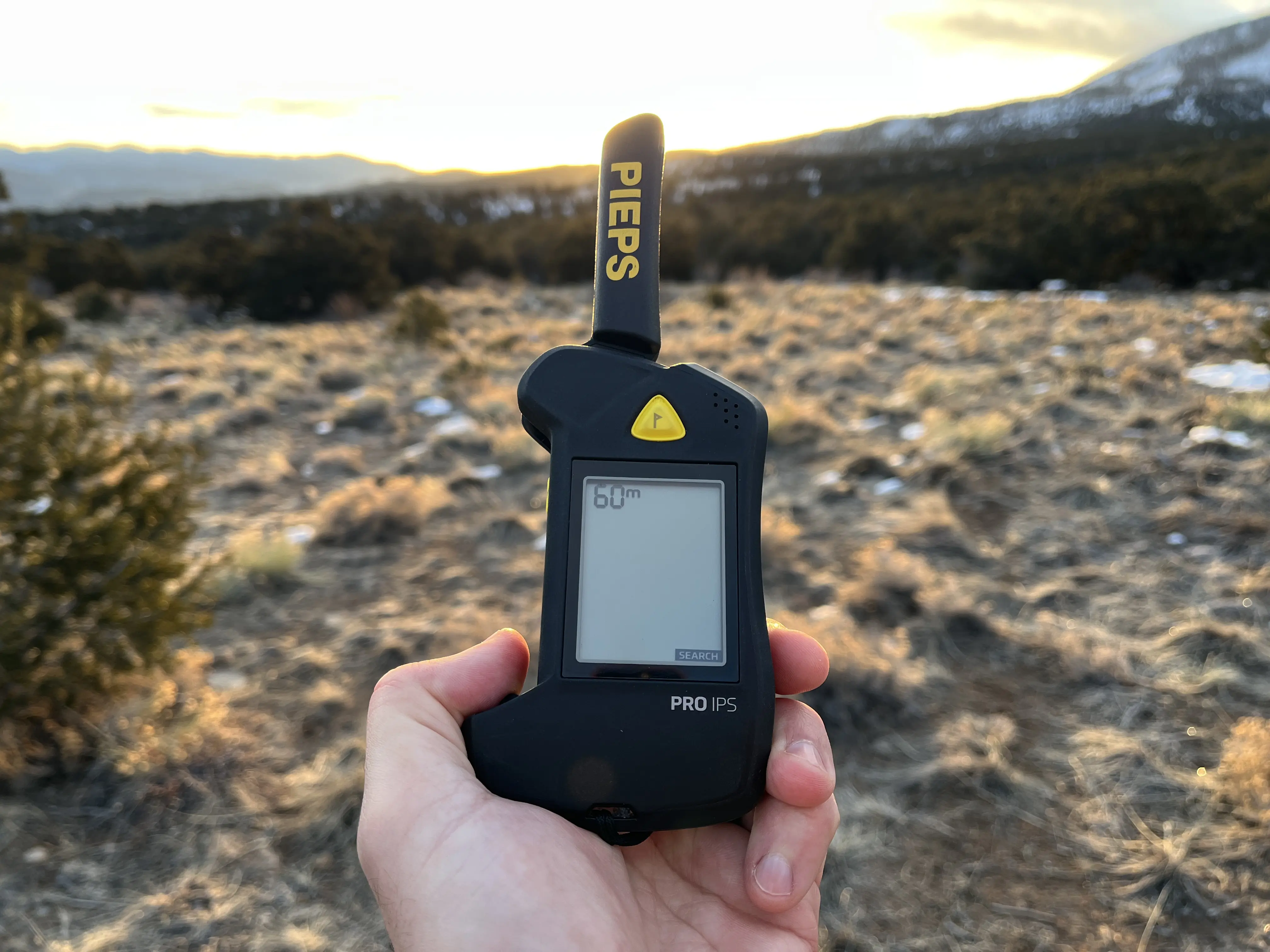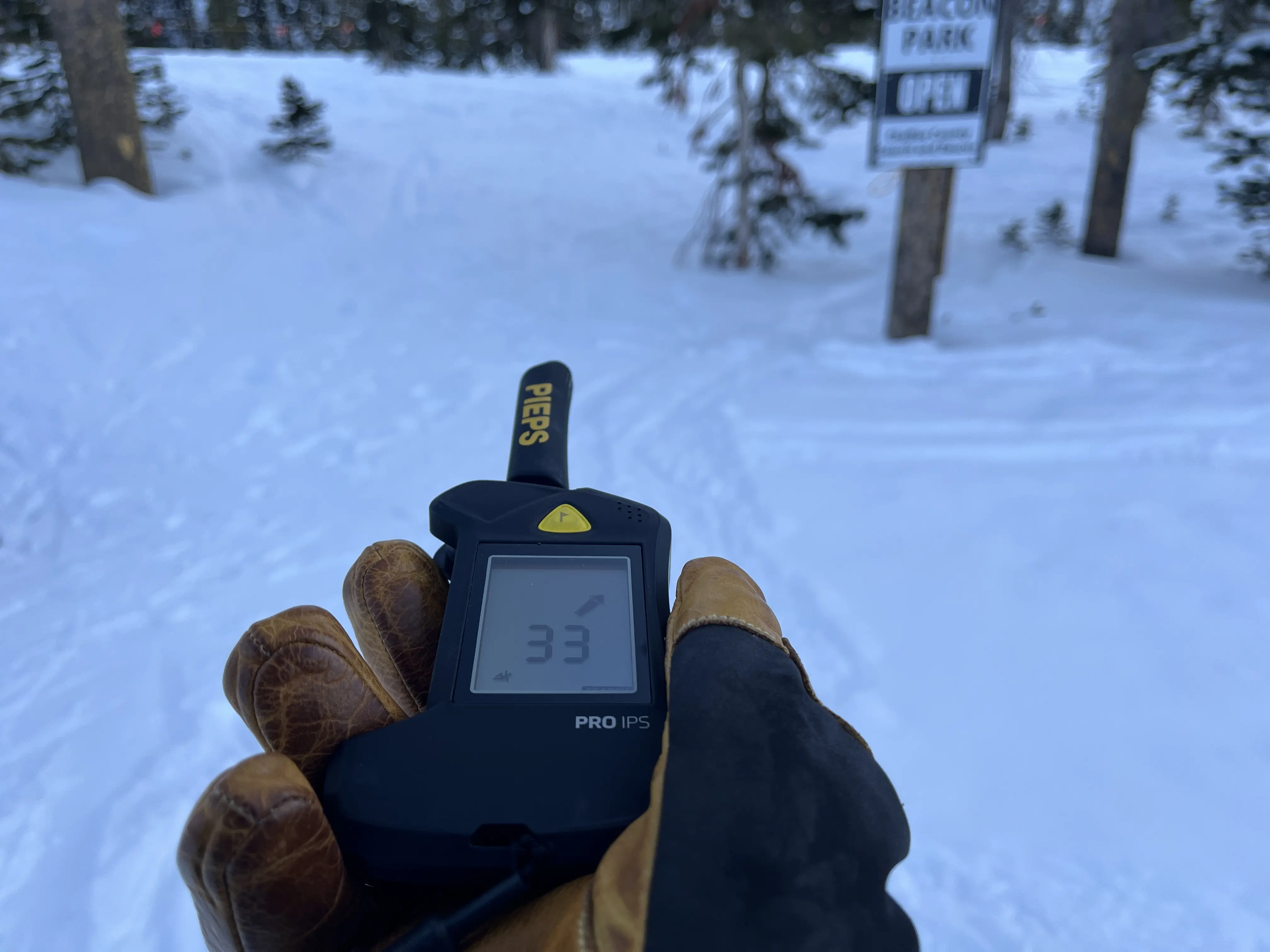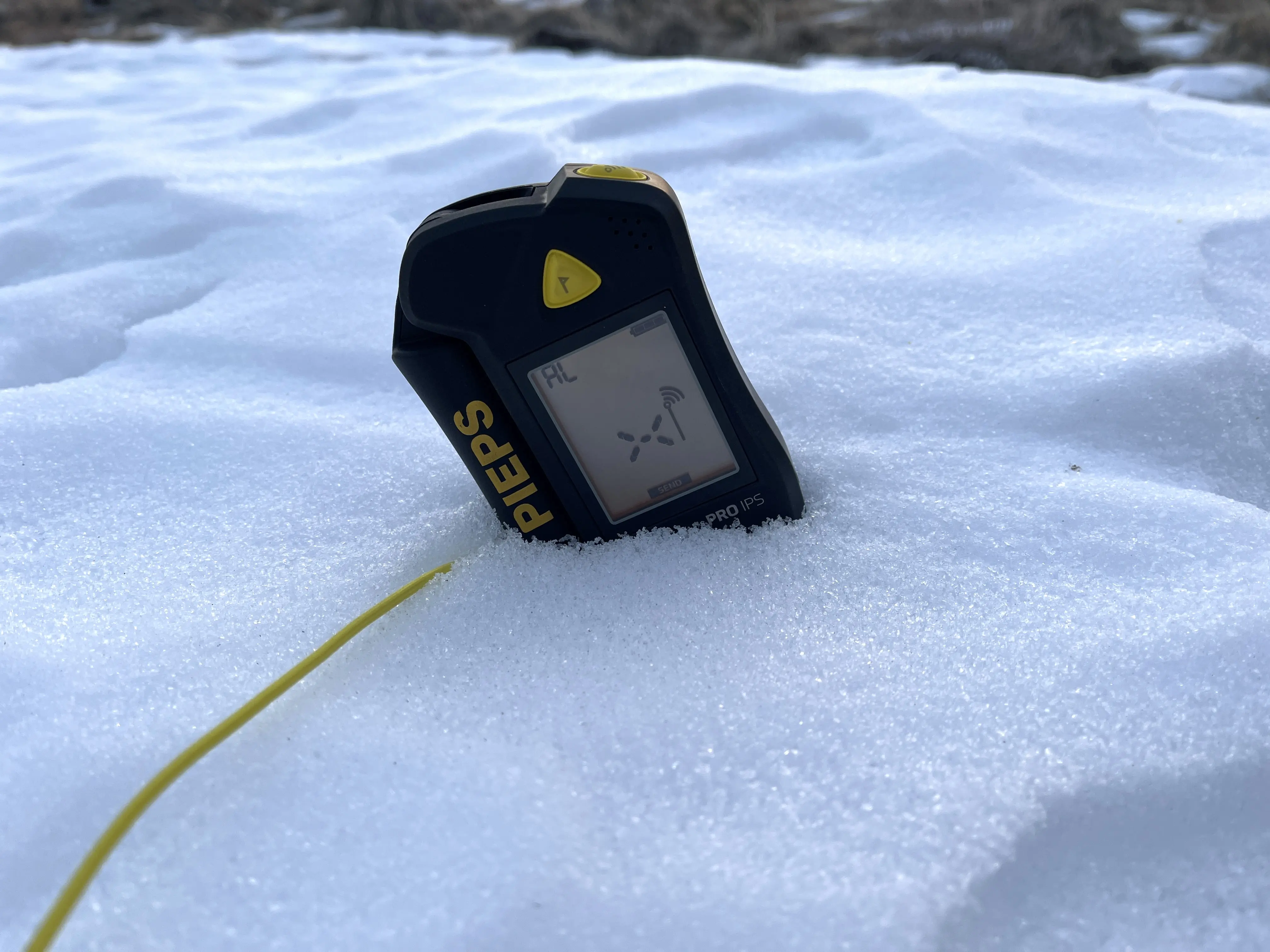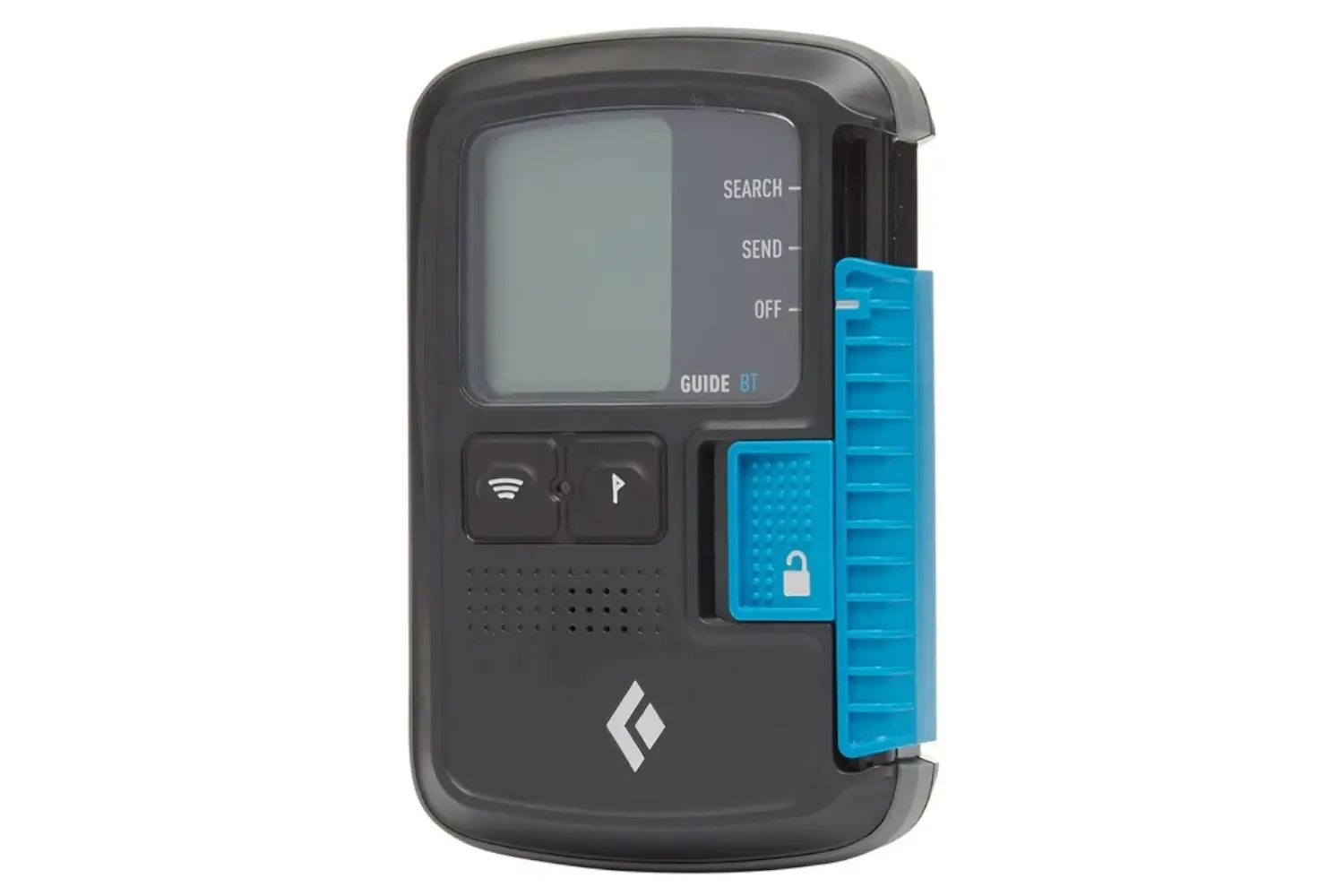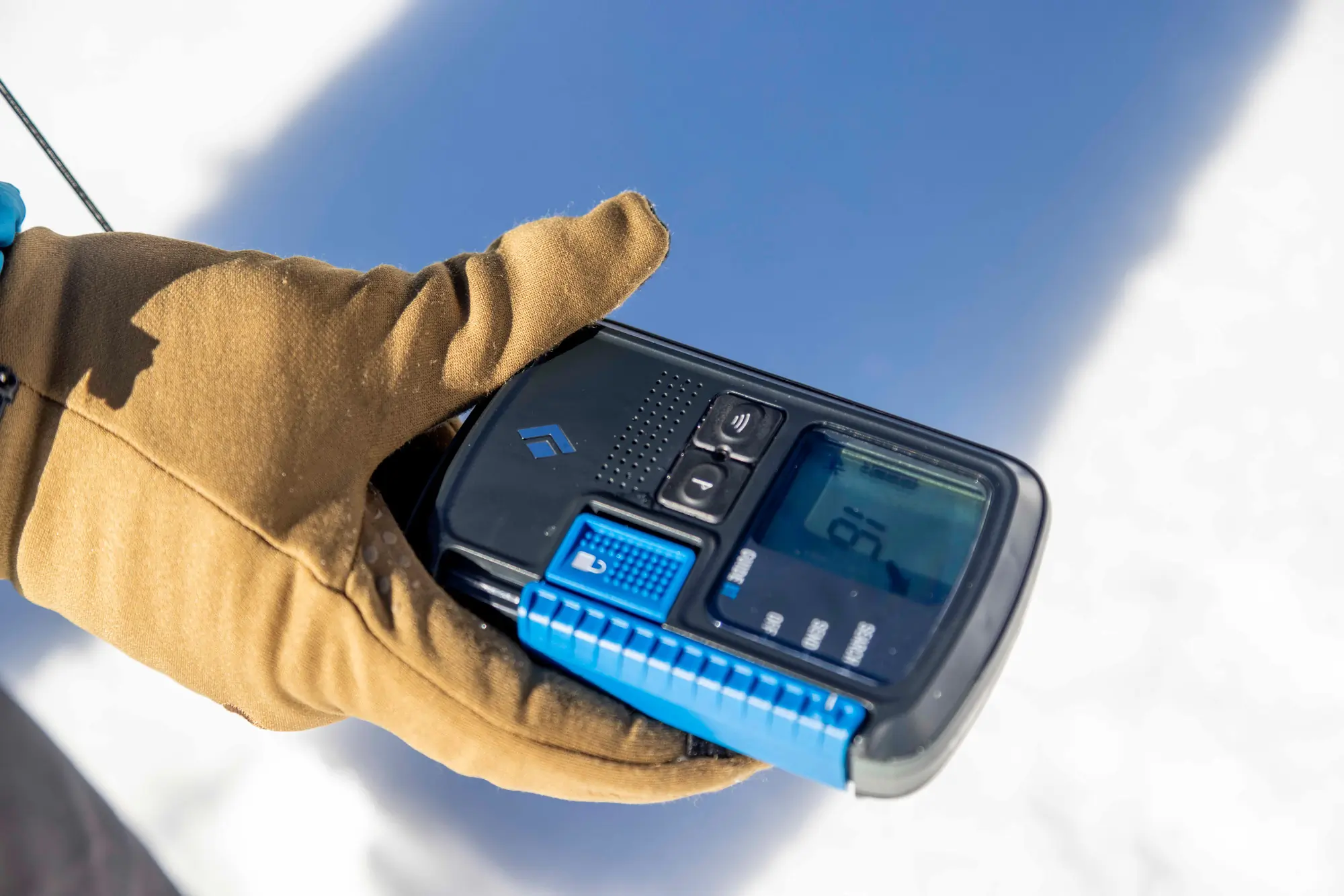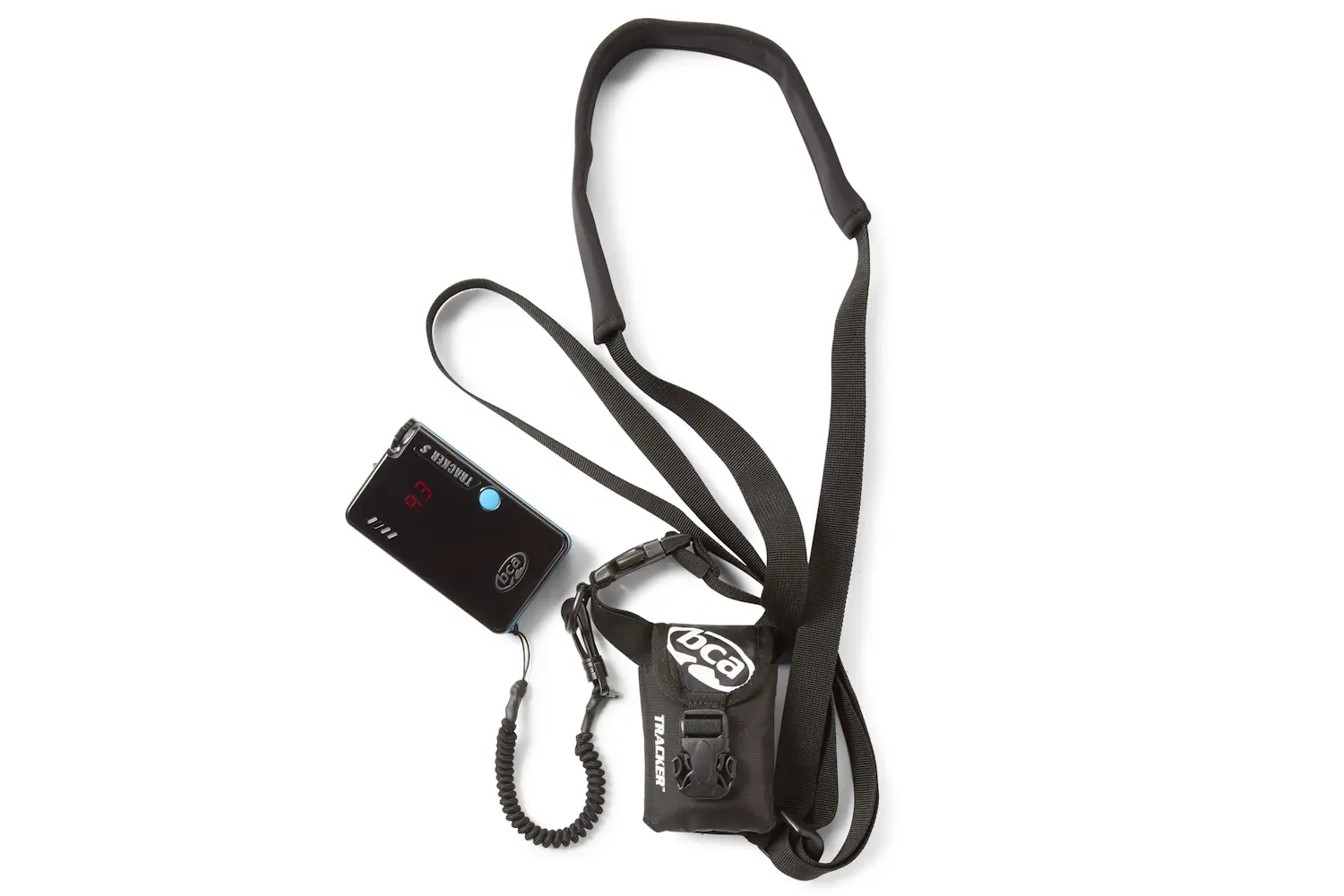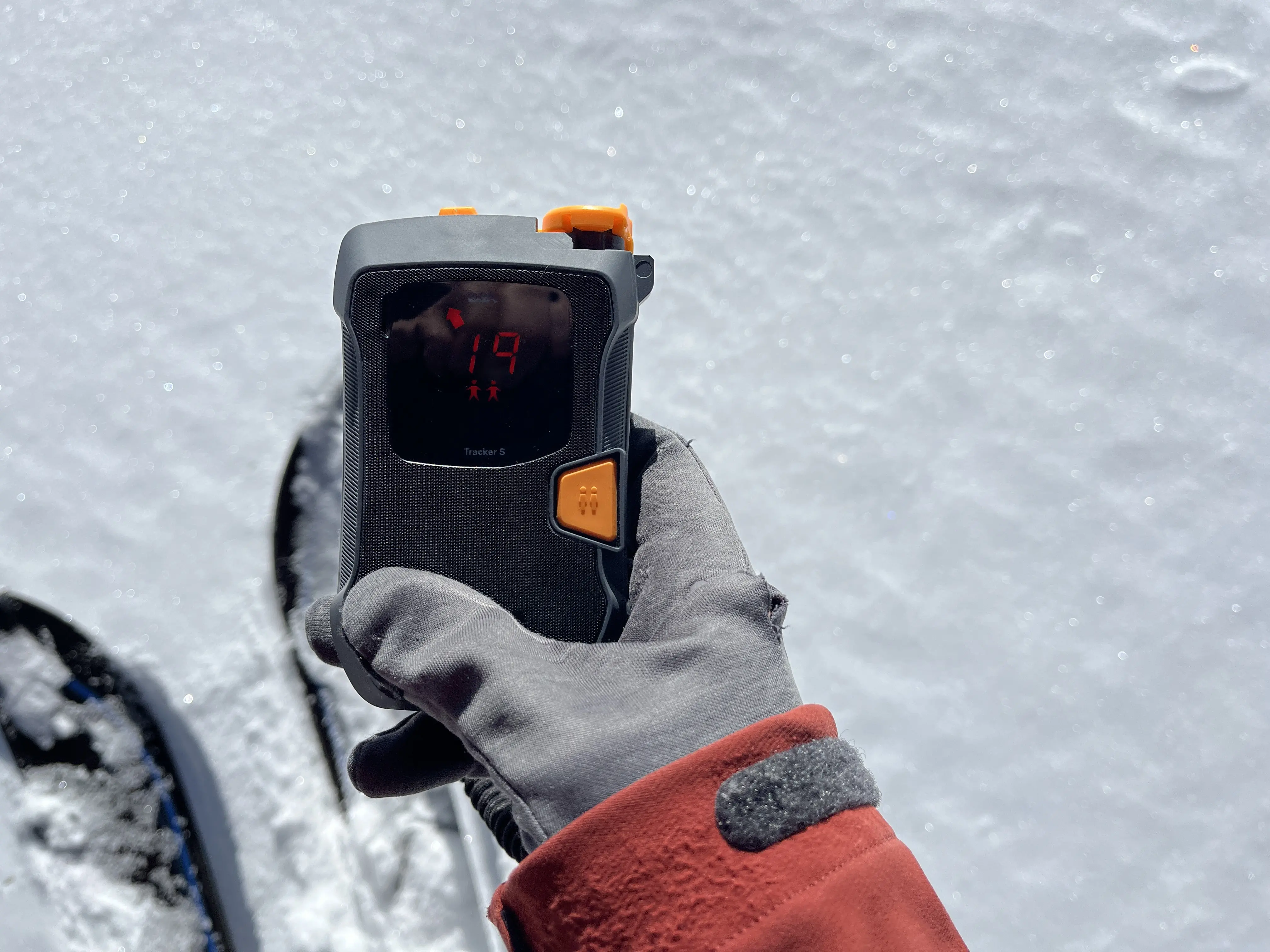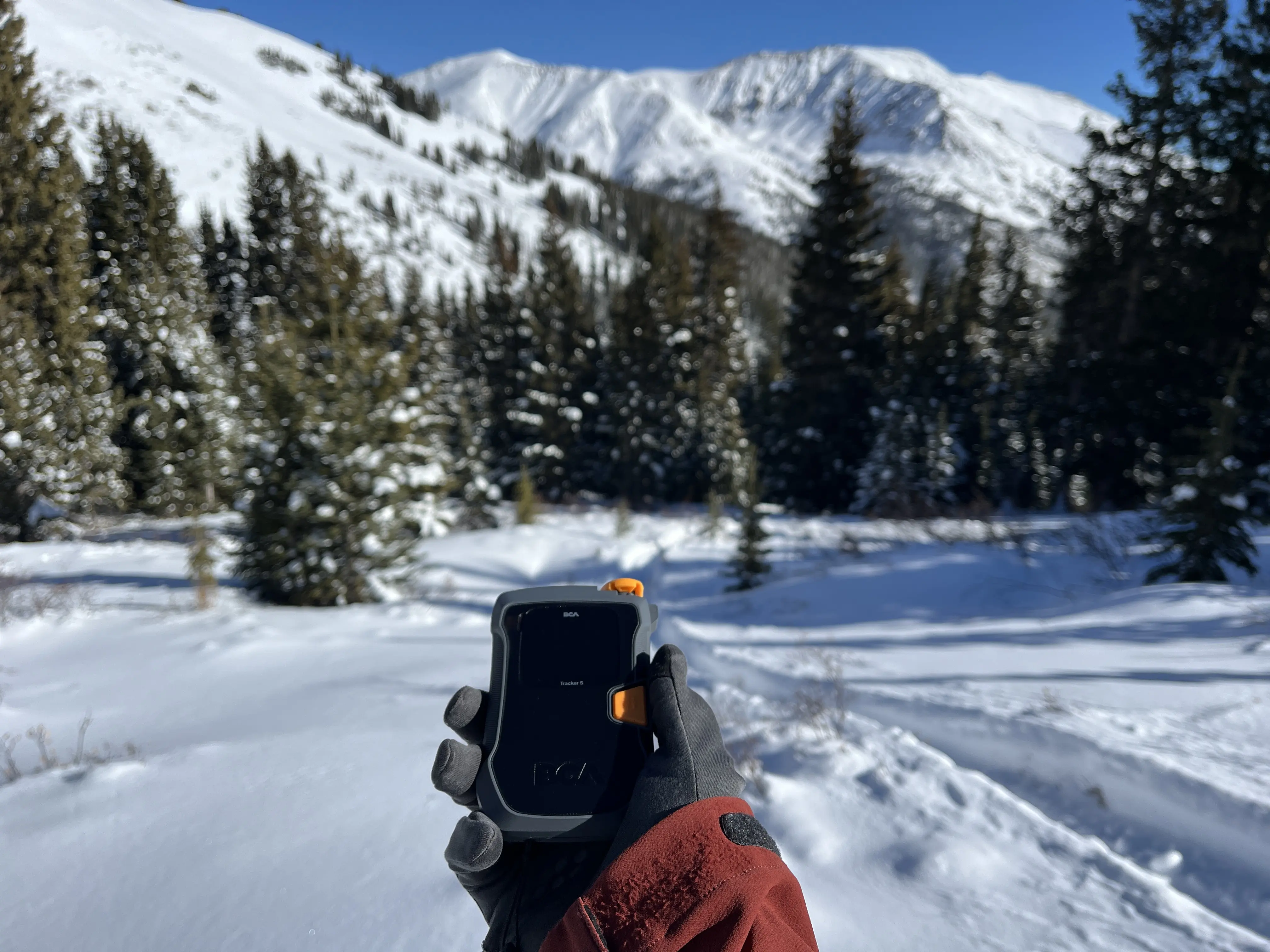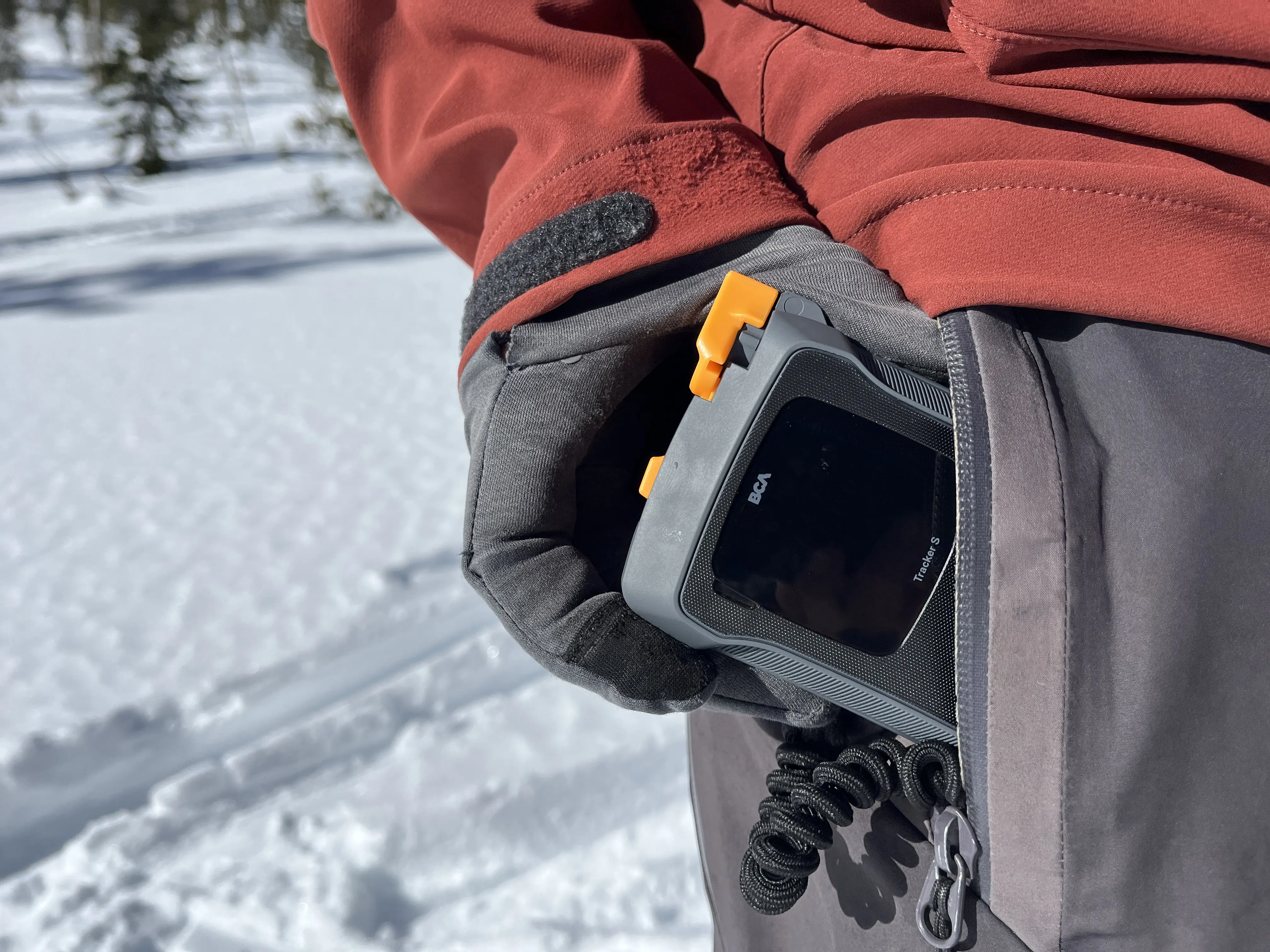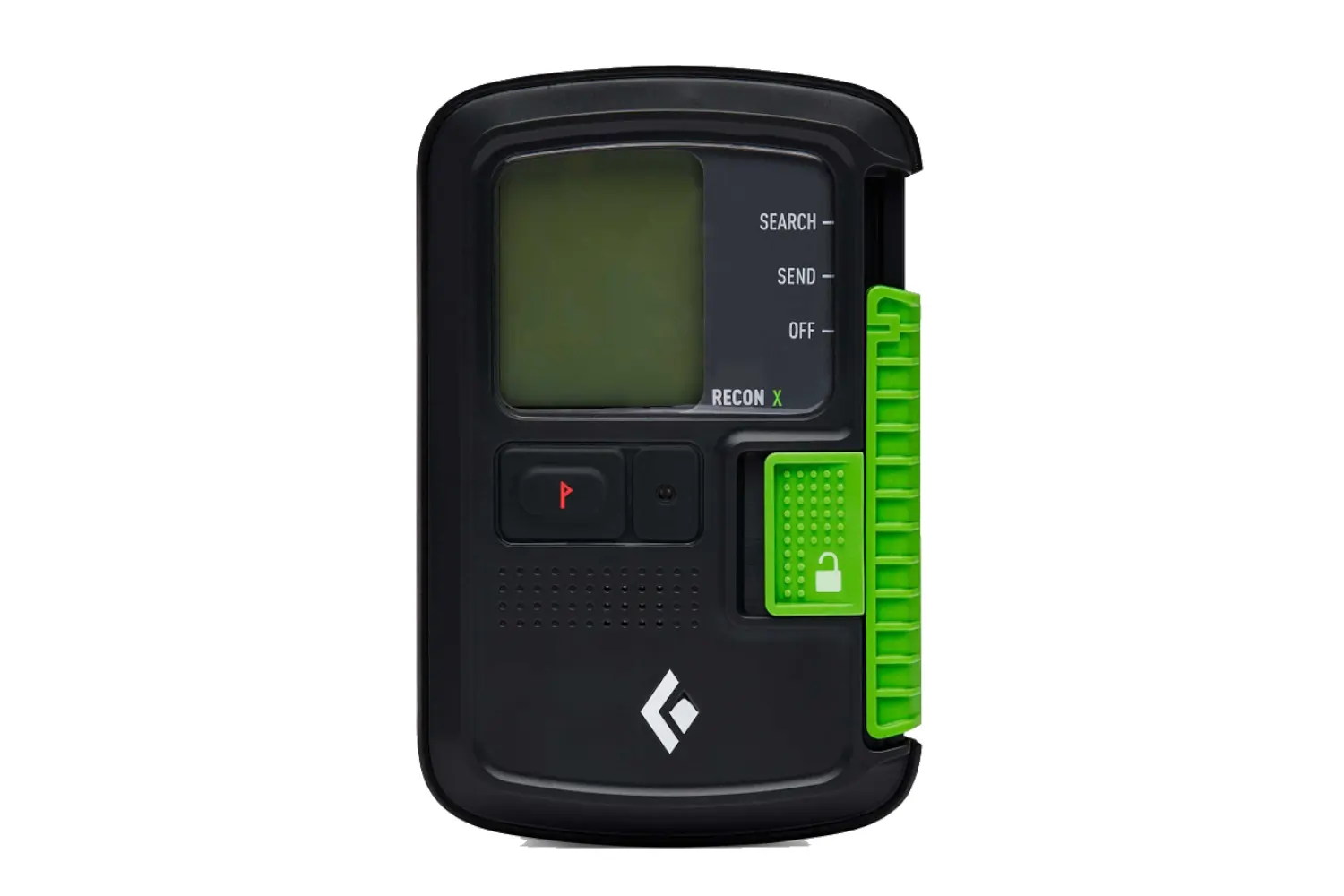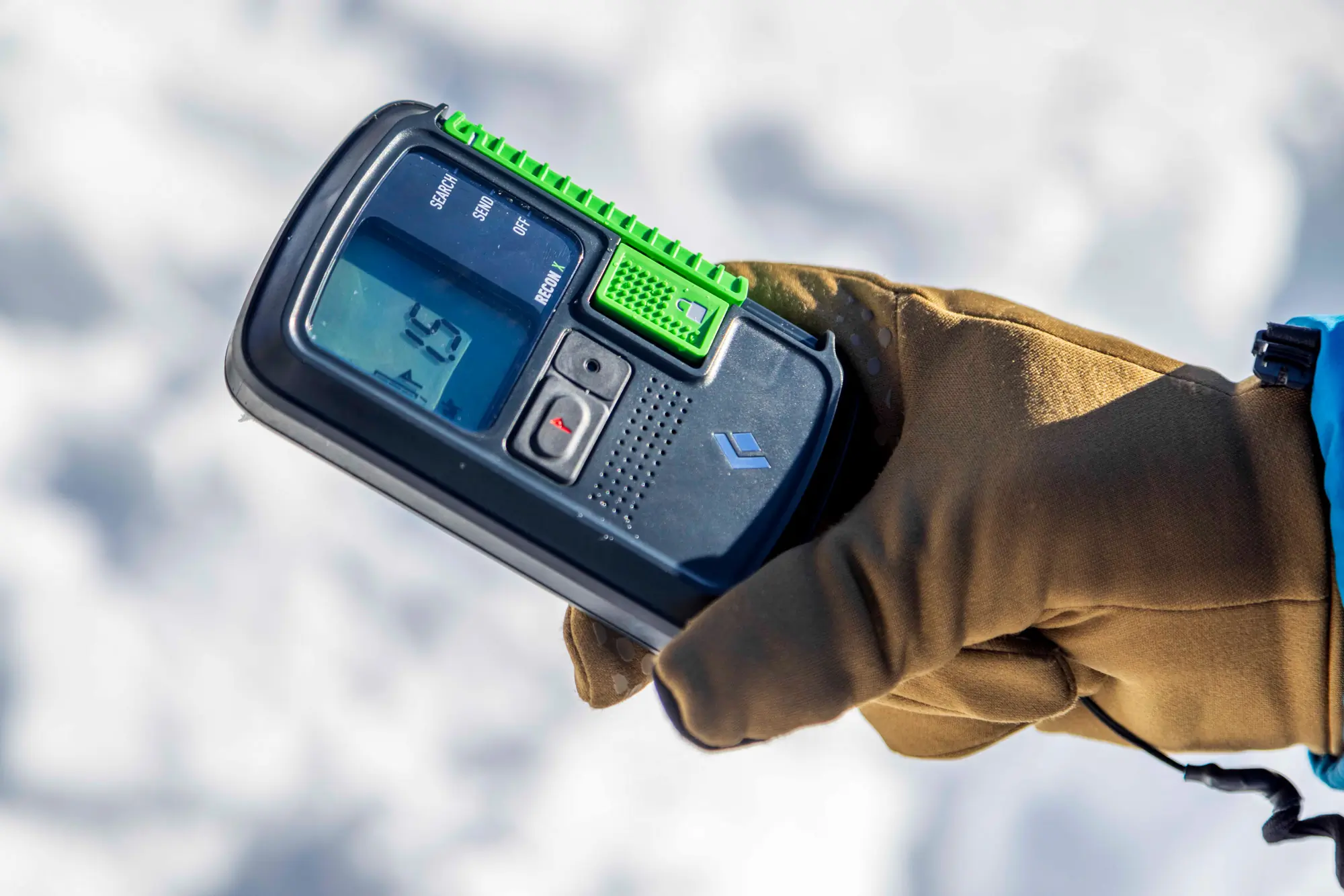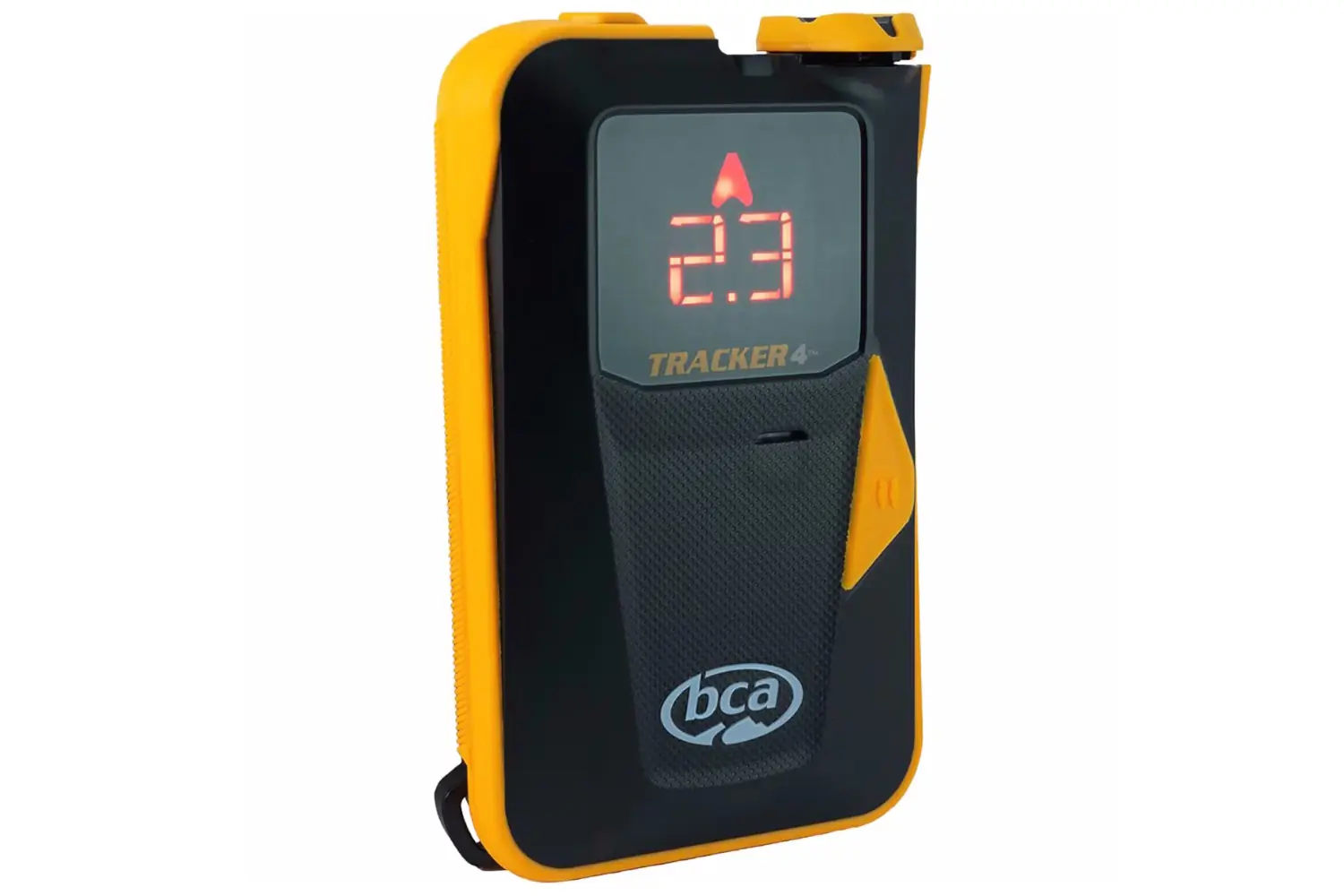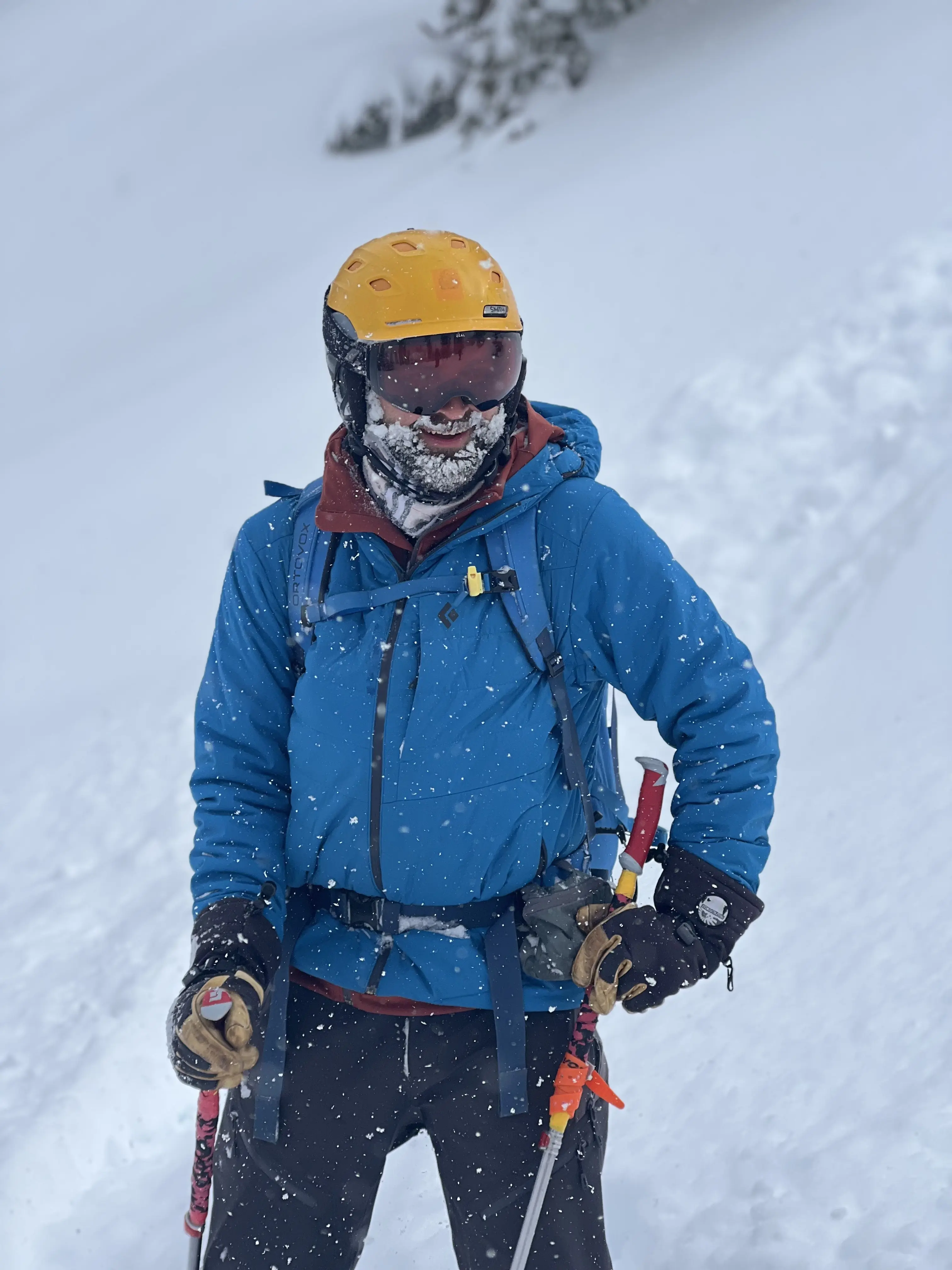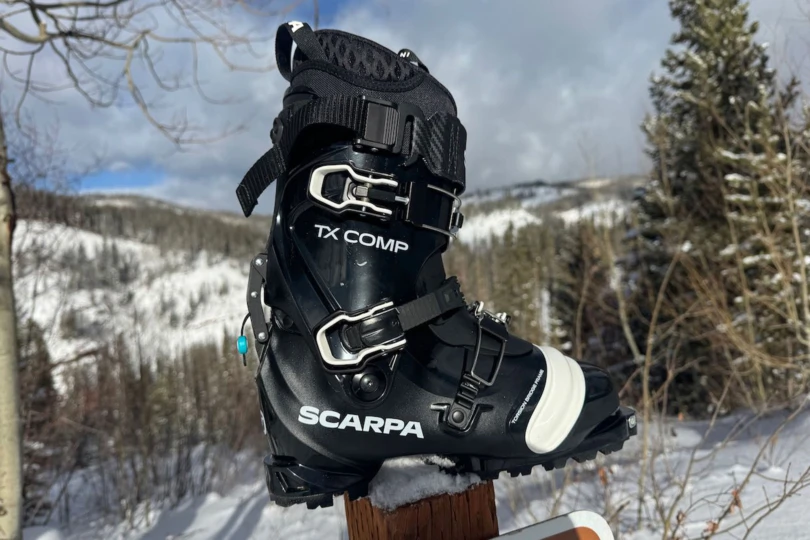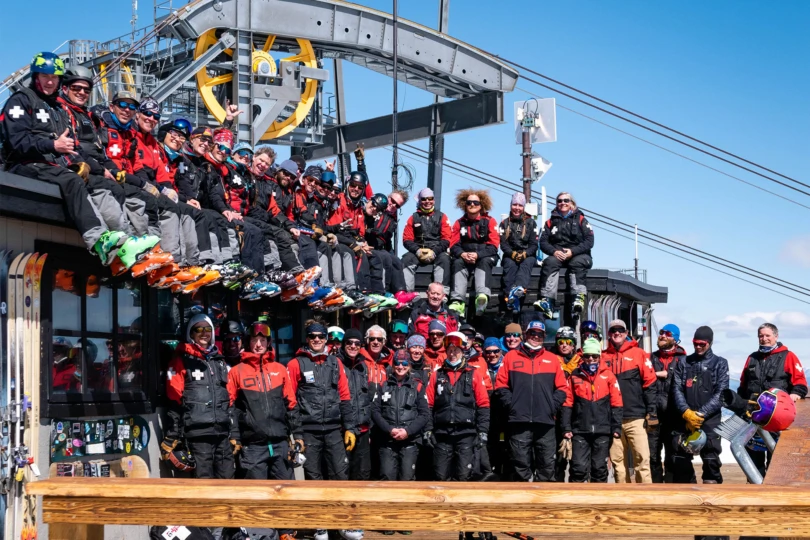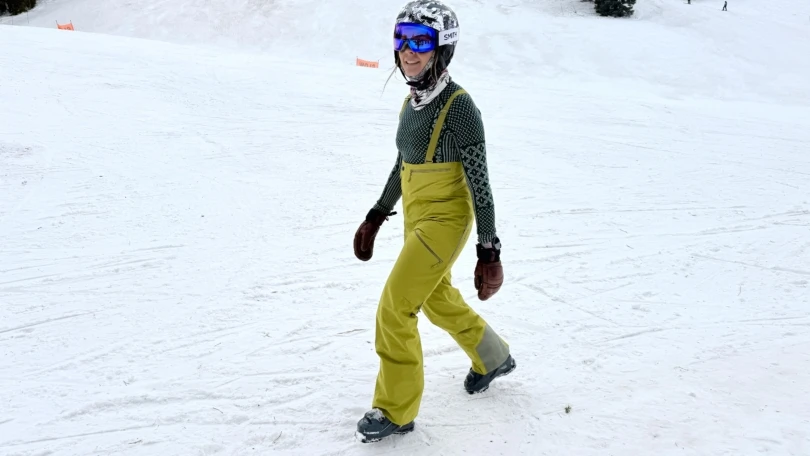Choosing the best avalanche beacon (also called a transceiver) is one of the most important decisions any winter backcountry traveler can make. Skis, boots, and bindings get a lot of attention, but your rescue equipment—including a reliable beacon—can make the ultimate difference in an emergency. If you’re heading into avalanche terrain, make sure you’re carrying a beacon you know and trust.
We tested the top models head-to-head in a variety of scenarios, from straightforward single burials to complex multiple-victim searches. Lead tester Spencer Herford, an AIARE Course Leader with over 20 years of beacon experience, ran each model through rigorous drills and real-world simulations in the central Rockies of Colorado.
To mimic realistic conditions, Spencer brought in professional colleagues, former students, and longtime ski partners to assist with testing. We evaluated each beacon on ergonomics, ease of use, range, update capability, and standout features.
This guide outlines the best choices for your needs, whether you’re looking for a budget-friendly unit like the Mammut Barryvox or a feature-rich option like the Arva EVO BT.
Editor’s Note: On August 18, 2025, we updated this guide with the Mammut S2 Barryvox, our newly awarded top pick for professionals. We also added overall ratings to provide insight into our rankings.
The Best Avalanche Beacons of 2025
Top Picks
Arva EVO BT
- Advertised Range: 60 m
- Battery: AAA Alkaline or Lithium
- Flagging Feature: Yes
- Group Check: Yes
- Auto Revert to Send: Yes
- User Updatable Firmware: Yes
Pros
- Good ergonomics
- Long distance signal acquisition
- Clear backlit screen
- Group check mode tests transmit frequency and power
- Excellent performance in single and multiple burial scenarios
Cons
- Arva beacons tend to be harder to find in the U.S.
- Beacon may feel small in hand if you have large hands
Mammut Barryvox
- Advertised Range: 70 m
- Battery: AAA Alkaline
- Flagging Feature: Yes
- Group Check: Yes
- Auto Revert to Send: Yes – four minutes
- User Updatable Firmware: No
Pros
- Tenacious signal lock, no matter how sloppy the user is
- Long range
- Great ergonomics
- Easy to read screen with best-of-the-best intuitive user interface
Cons
- Multiple burial techniques like micro search strips are much harder to do with this beacon due to the tendency to lock onto signals and not let go
- Long range comes at a cost of potential interference issues
- Slower processing speed in the fine search
Mammut Barryvox S2
- Advertised Range: 70 meters
- Battery: AAA Alkaline or Lithium
- Flagging Feature: Yes
- Group Check: Yes
- Auto Revert to Send: Yes
- User Updatable Firmware: Yes
Pros
- High quality screen with clear directions
- Intelligent fine search guidance provides good direction in a critical phase of rescue
- Long and reliable signal acquisition range
Cons
- Very expensive
- Overkill for most users
Ortovox Diract Voice
- Advertised range: 50 m search strips
- Battery: Rechargeable lithium-ion
- Flagging feature: Yes
- Group check: Yes
- Auto revert to send: Yes
- User updatable firmware: Yes via app
Pros
- Feels great in hand
- Smart design choices
- Large and easy-to-read screen
- Voice assistance can keep rescuers on track, especially in the signal search phase
Cons
- Noticeably shorter range
- Rechargeable battery is not for everyone
- Voice assistance could be more fleshed out
Other Avalanche Beacons We Trust
- Advertised Range: 70 m
- Battery: AAA Alkaline or Lithium
- Flagging Feature: Yes
- Group Check: Yes
- Auto Revert to Send: Yes
- User Updatable Firmware: Yes
Pros
- Long-range, fast processor
- Simple & effective antenna flip to move from send to search
- Interference Protection System and Dual Antenna Signal Processing are welcome and noticeable technical innovations
Cons
- Buttons can be hard to push for some users
- Included harness tether feels very short
- Advertised Range: 60 m
- Battery: Alkaline or Lithium AAA
- Flagging Feature: Yes
- Group Check: Yes
- Auto Revert to Send: Yes, disabled by default
- User Updatable Firmware: Yes via app
Pros
- Professional-grade beacon
- Excellent performance in single and multiple burials
Cons
- Slider to change modes has had a problematic history, and the redesign to fix previous issues is now harder to operate for some folks
- Included harness tether is too short
- Advertised Range: 50 m
- Battery: AAA Alkaline
- Flagging Feature: Signal Suppression for 60 seconds
- Group Check: No
- Auto Revert to Send: Yes. It must be activated every time when powering up (5-minute timer)
- User Updatable Firmware: No
Pros
- Simple and proven user interface
- Glove-friendly design
Cons
- Multiple burial performance suffers due to signal suppression quirks
- The simple digit display is not as intuitive and straightforward as other beacons tested
- Advertised range: 60 m
- Battery: Alkaline or lithium AAA
- Flagging feature: Yes
- Group check: Yes
- Auto revert to send: Yes, enabled in app
- User updatable firmware: Yes, via app
Pros
- Excellent performance in single and multiple burials
- Great value
- Fast performance in fine search
Cons
- Slider to change modes has had a problematic history, and the redesign to fix previous issues is now harder to operate for some folks
- Screen is small/can be tough to see
- Advertised Range: 50 m
- Battery: AAA Alkaline
- Flagging Feature: Signal suppression for 60 seconds
- Group Check: No
- Auto Revert to Send: Yes, must be activated every time when powering up
- User Updatable Firmware: Yes, via PC connection (mac not supported)
Pros
- Fast processing
- Simple and proven user interface
- Glove-friendly design
Cons
- As useful as big picture mode is, multiple burial performance suffers due to signal suppression quirks
- Letter designations and icons are not as intuitive as other beacons tested
Avalanche Beacon Comparison Chart
| Avalanche Beacon | Price | Advertised Range | Battery | Flagging Feature | Group Check | Auto Revert to Send | Updatable Firmware |
|---|---|---|---|---|---|---|---|
| Arva EVO BT | $389 | 60 m | AAA Alkaline or Lithium | Yes | Yes | Yes | Yes |
| Mammut Barryvox | $299 | 70 m | AAA Alkaline | Yes | Yes | Yes – four minutes | No |
| Mammut Barryvox S2 | 70 m | AAA Alkaline or Lithium | Yes | Yes | Yes | Yes | |
| Pieps Pro IPS | $530 | 70 m | AAA Alkaline or Lithium | Yes | Yes | Yes | Yes |
| Ortovox Diract Voice | $450 | 50 m search strips | Rechargeable Lithium Ion | Yes | Yes | Yes | Yes via app |
| Black Diamond Guide BT | $500 | 60 m | Alkaline or Lithium AA | Yes | Yes | Yes, disabled by default | Yes via app |
| BCA Tracker S | $299 | 50 m | AAA Alkaline | Signal Suppression for 60 seconds | No | Yes. It must be activated every time when powering up, (5-minute timer) | Yes, it must be activated every time when powering up |
| Black Diamond Recon X | $350 | 60 m | Alkaline or lithium AAA | Yes | Yes | Yes, enabled in app | Yes, via app |
| BCA Tracker 4 | $399 | 50 m | AAA Alkaline | Signal suppression for 60 seconds | No | Yes, must be activated every time when powering up | Yes, via PC connection (mac not supported) |
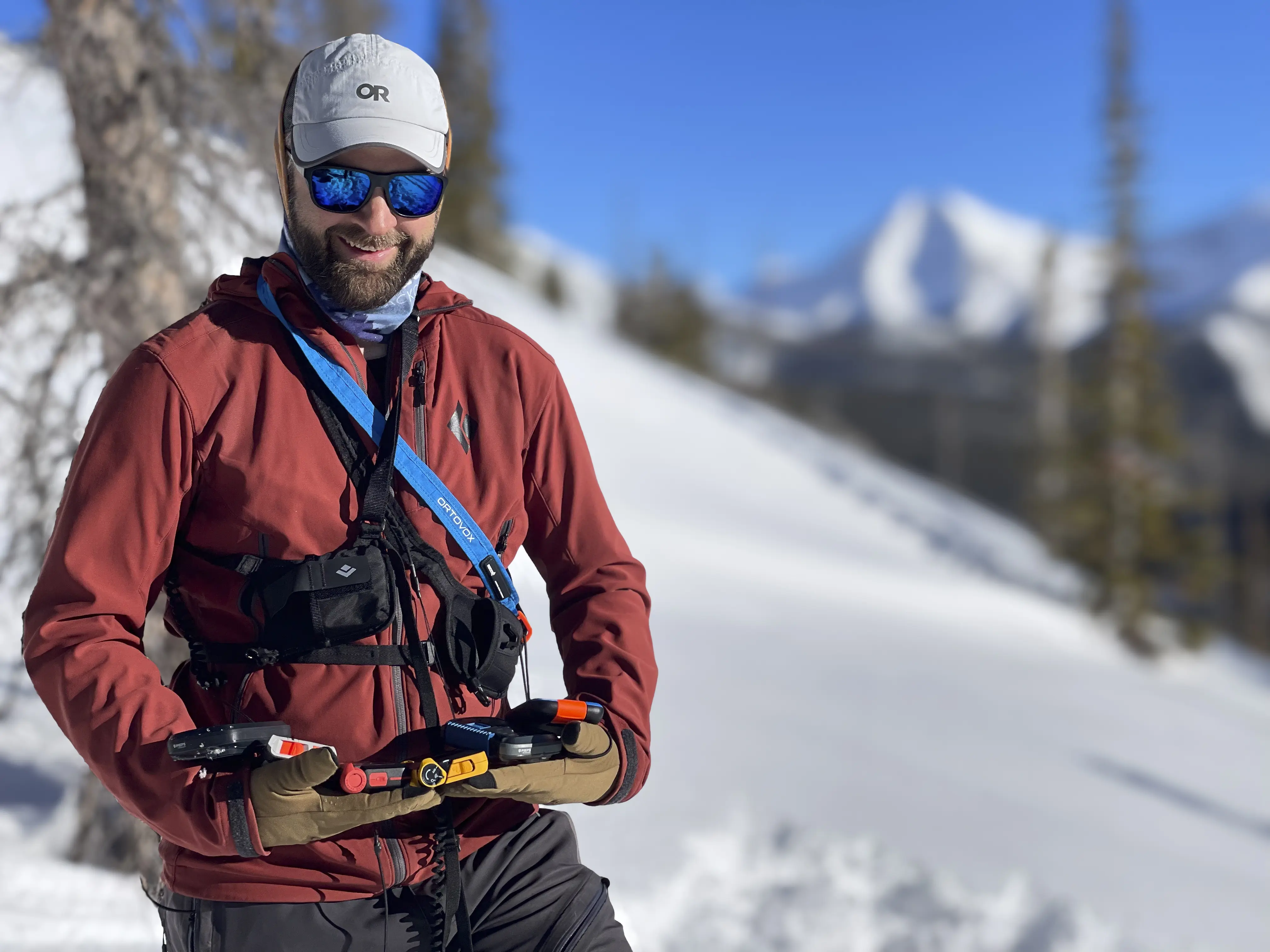
How We Tested Avalanche Beacons
Our Expert Testers
Our main tester, Spencer Herford, is an avalanche instructor, backcountry skier, and split boarder who has been using beacons for over two decades. He is an AIARE Course Leader, split board and ski guide, and a graduate of the Colorado Mountain College Avalanche Science Program. Fortunate enough to learn from countless leaders in the avalanche safety realm about snow science and rescue, Herford has participated in, led, and designed countless rescue scenarios.
As an avalanche educator, he has had the honor of starting many people’s backcountry careers. Often, this includes coached rescue drills. As a result, he gets to see every beacon on the market used in a range of rescue scenarios. This makes him uniquely poised to advise how each beacon shines and where each could use some improvement. Because he is out there over 100+ days a year, year after year, Herford also stays abreast of technological advancements. He also has his finger on the pulse of improvements (or failures) made on beacons from year to year.
Our Testing Grounds & Process
Scenarios
We used each beacon in single and multiple burial rescue scenarios designed to mimic real situations a rescuer might face. Each beacon was tested multiple times in these mock rescues. We looked at how fast each processed signals and how well it handled EMI. We also tested to see how it operated with gloves on and how intuitive it was to use. We enlisted the help of backcountry partners, former students, and professional colleagues to give more targeted feedback on scenarios.
We tested in several venues in central Colorado, many of which are used in avalanche education courses. These are usually large open areas free from distraction that simulate a debris pile. Each scenario started from the point last seen, which was outside of the search area. We then turned the beacon to search mode and started search strips to find the signal, usually in 40 m strips.
As we tested beacons, we also tried the manufacturer’s recommended search strips to gauge how well those worked. Once a signal was acquired, we followed the arrows and distance to the sending beacon. As we approached below five m, we did our fine search with the beacon close to the snow surface. After finding the lowest number, we verified with a probe strike.
In the Backcountry
Beyond rescue simulations, we also carried these beacons on personal backcountry tour days. We did trailhead departure checks to ensure each member had adequate battery power (usually above 60%) and could send and receive a signal. We also looked for how well the supplied harness carried the beacon or how the beacon fit into a dedicated rescue pocket in ski pants. If you’re looking to round out the rest of your touring kit, check out our guides to the best backcountry skis, backcountry bindings, backcountry boots, and our latest round-up of the best climbing skins.
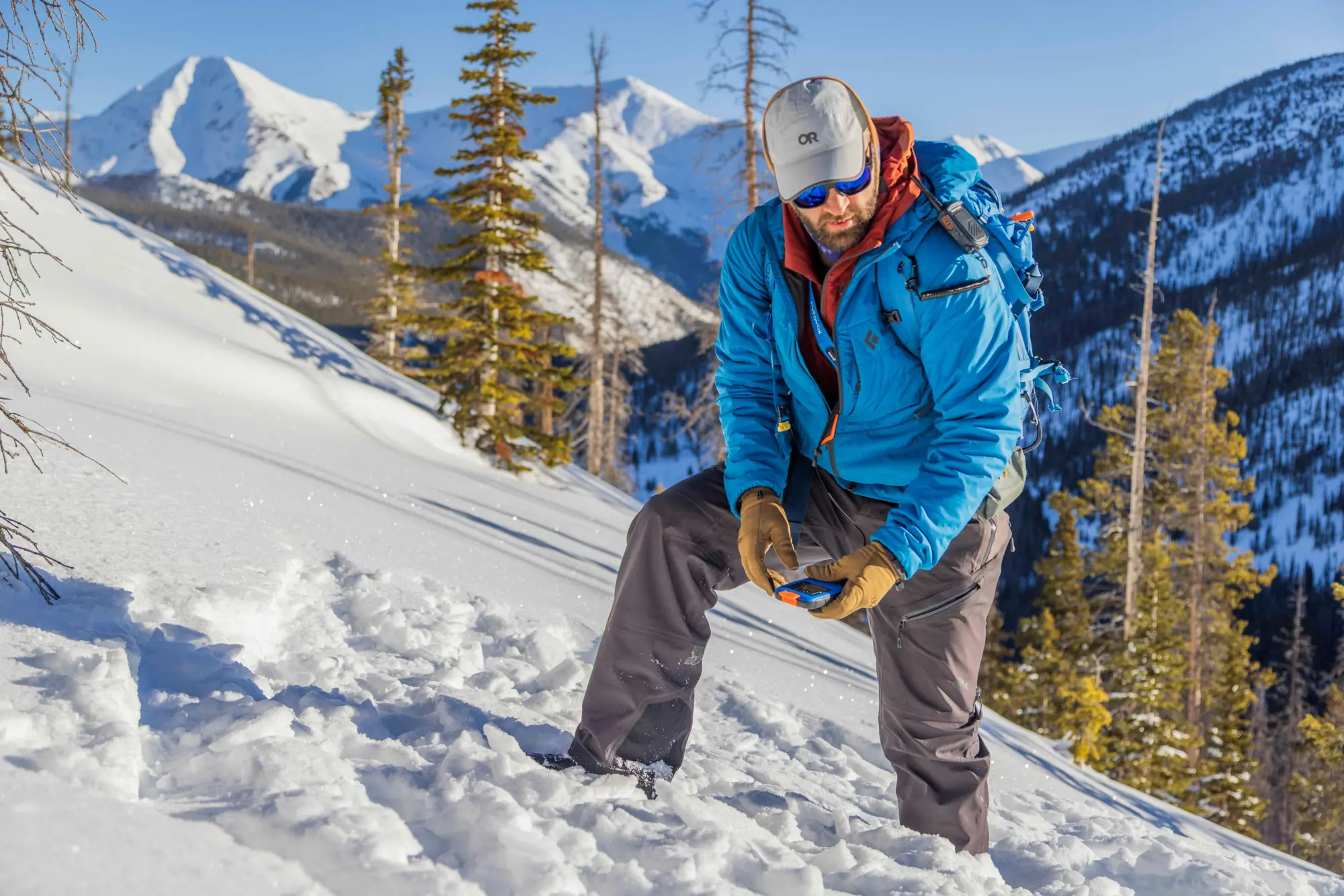



Buyer’s Guide: How to Choose the Best Avalanche Beacons
Avalanche rescue technology is an ever-changing landscape. Just look at how beacon technology has changed in recent memory. We started with single-antenna analog beacons that were difficult to use. We have now progressed to new modern three-antenna beacons that are incredibly intuitive and fast, even for new users. We would recommend you consider a few things when choosing an avalanche beacon.
Ergonomics
Everyone has different-sized hands and uses different types of gloves outside in winter. Some folks deal with freezing hands and use thicker gloves. We encourage you to wear the gloves you plan to use most often when trying out beacons.
Make sure you can turn it on and switch modes effectively. Taking gloves off to use rescue gear can lead to cold or wet hands. We tried each beacon with various gloves to see how easy it was to use. The Ortovox Diract Voice stood out among the tested beacons as the most comfortable and easy to use.
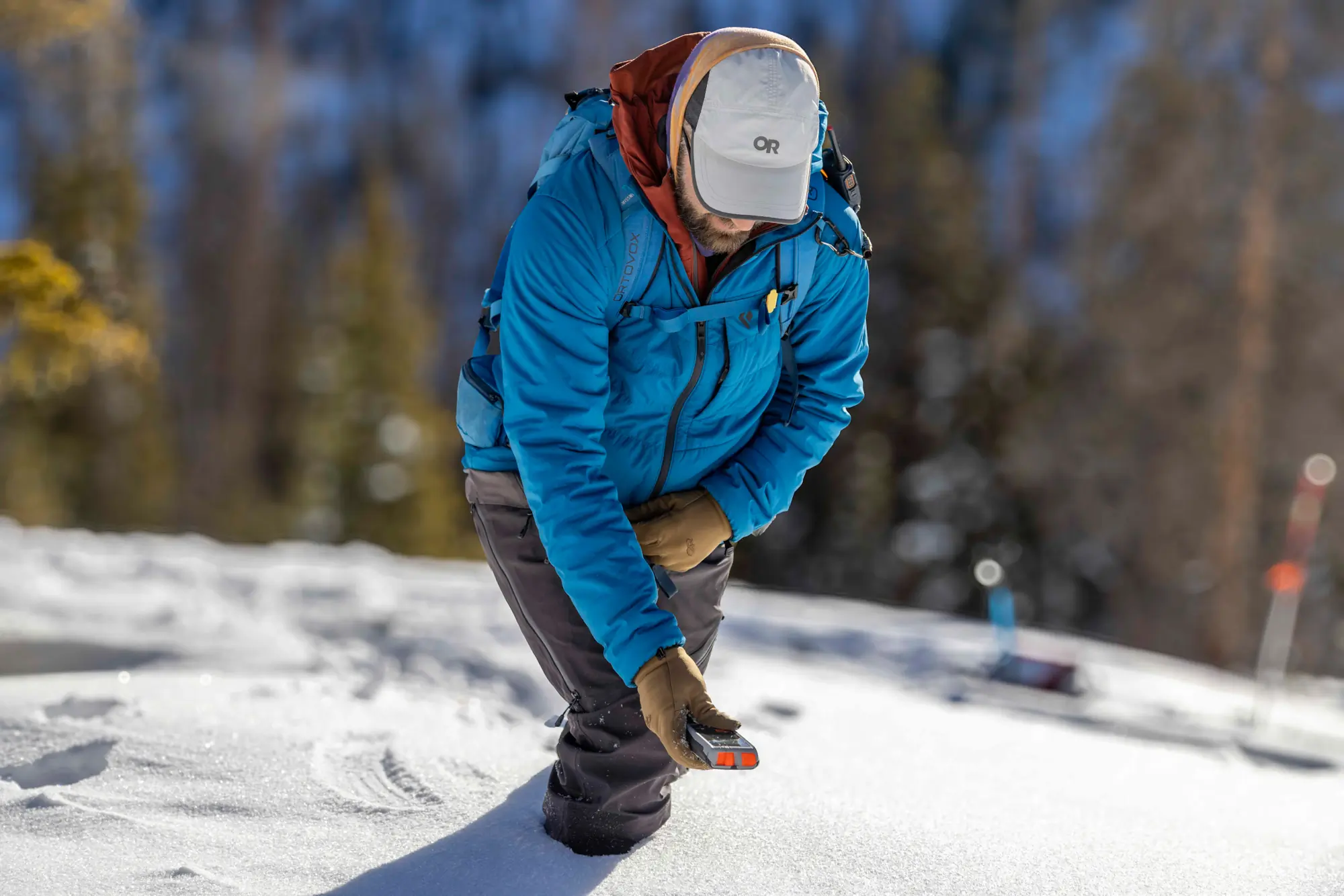



Range
Range, or the distance from which a beacon can pick up a signal, is a complicated metric. Although important, it’s not the only factor to rely on when choosing a beacon. It makes sense to want to pick up a signal from as far away as possible because this allows rescuers to get to the actual grunt work of the rescue (shoveling) more quickly.
However, in some cases, the ability to pick up a signal at a more extended range comes from a beacon’s increased sensitivity. Ultra-sensitive beacons can be prone to more cases of EMI, which can make a rescue more difficult due to phantom signals or misdirection. Mitigating EMI is an area of notable innovation in the past few years.
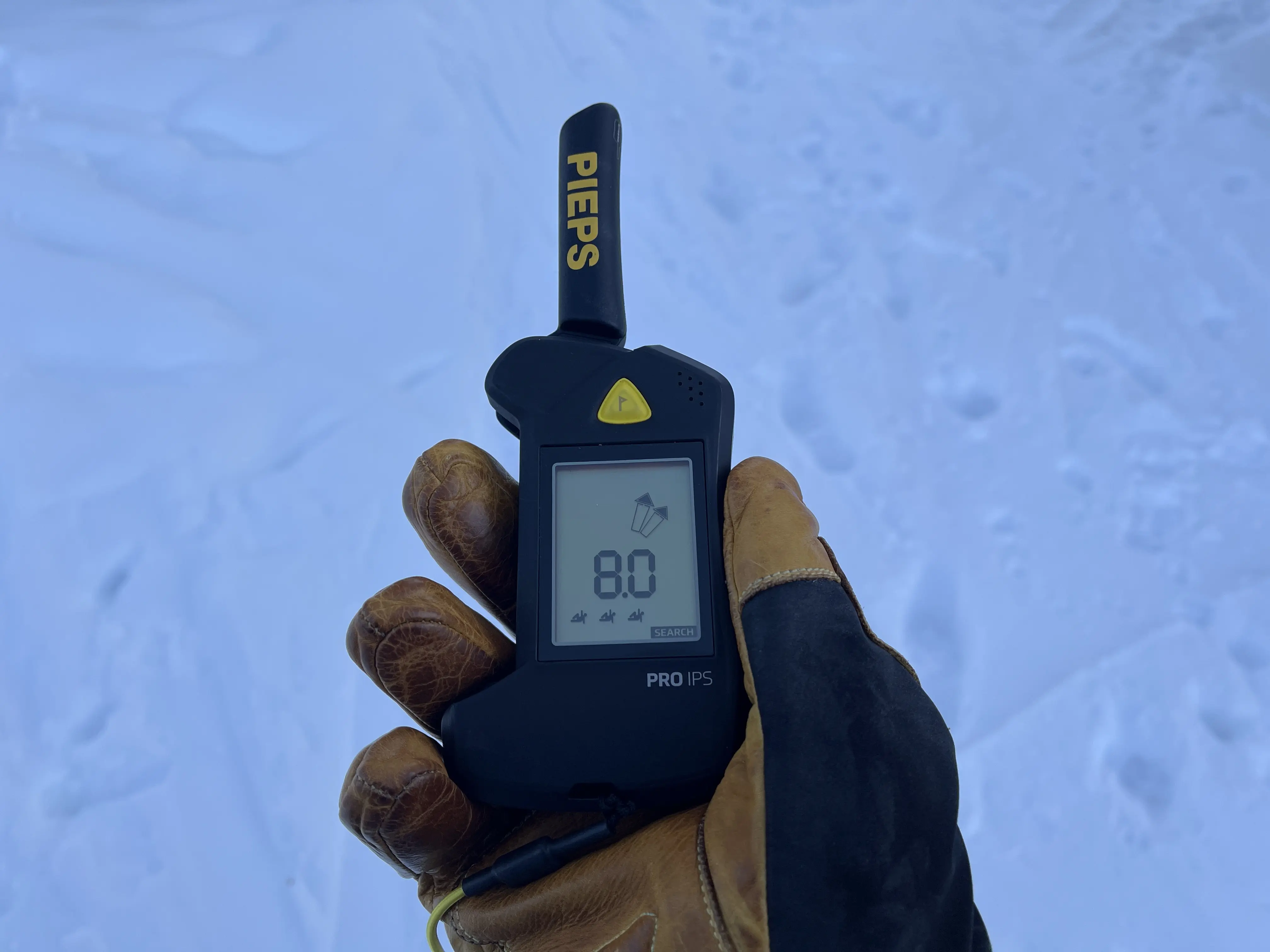



Many beacons are integrating software to handle this interference. In some cases, beacons can even mask it or process it out. Some beacons we tested will also notify you of EMI with an icon. Or, they will tell you to shorten search strips to better filter out the noise.
Generally, our testers recommend beacons with more extensive receiving ranges because rescuers can close the gap to a victim faster. It also increases the potential to pick up multiple buried victims faster to deploy resources better. The Mammut Barryvox S2, Arva Evo BT, Pieps Pro IPS, and Mammut Barryvox are the clear winners for range in the test. The Black Diamond BT Pro and Recon X rank close behind.
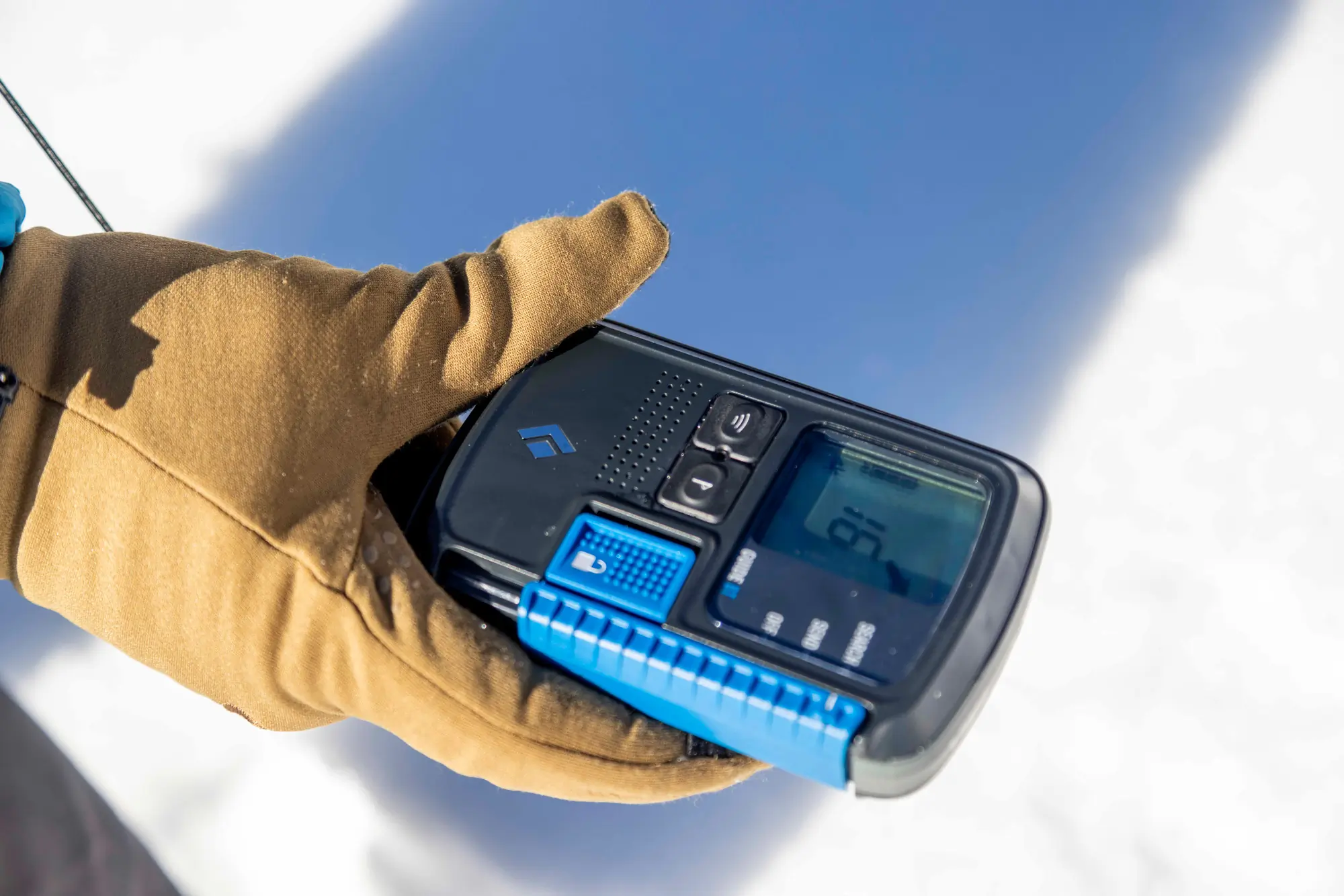



Special Features
At the basic level, an avalanche beacon needs to be able to send and receive a signal from other beacons. Beyond that, we see a few special features that can be helpful depending on how you plan to use the beacon.
Flagging
A major one is a flagging mode, which essentially tells your beacon to ignore a signal and give information on the next signal. This is helpful in multiple burials; many professionals see this as essential. For recreationists, if you are skiing in avalanche terrain, the best rule you can follow is to expose only one person at a time to the hazard.
Many times, recreational avalanche rescues tend to involve only one buried individual, which makes flagging less critical. If you use flagging, you need to be absolutely sure you are masking the correct signal.
Group Check Mode
Beyond flagging, many beacons can feature a group check mode, which is helpful for making sure your partners are sending a signal. This mode shortens the beacon’s receiving range and allows for these departure checks even if there are many other groups around you.
Auto Revert to Send
Imagine if you were conducting a rescue and another avalanche came down on some of the rescuers. If they were all in search mode, rescuers not caught wouldn’t be able to find them if their beacons stayed in search mode. On some models, the “auto revert to send feature” kicks in when a beacon doesn’t sense movement for 2 to 4 minutes, and it automatically reverts to send.
Big Picture/Overview
The Black Diamond Guide BT and the BCA Tracker 4 both feature a special mode that gives an overview of the rescue field by showing where multiple signals may be located. The Black Diamond mode shows the number of beacons at different distances away, and the BCA mode cycles through all the signals with a direction and distance. For practiced users, this is a great tool for gauging how to deploy resources accordingly.
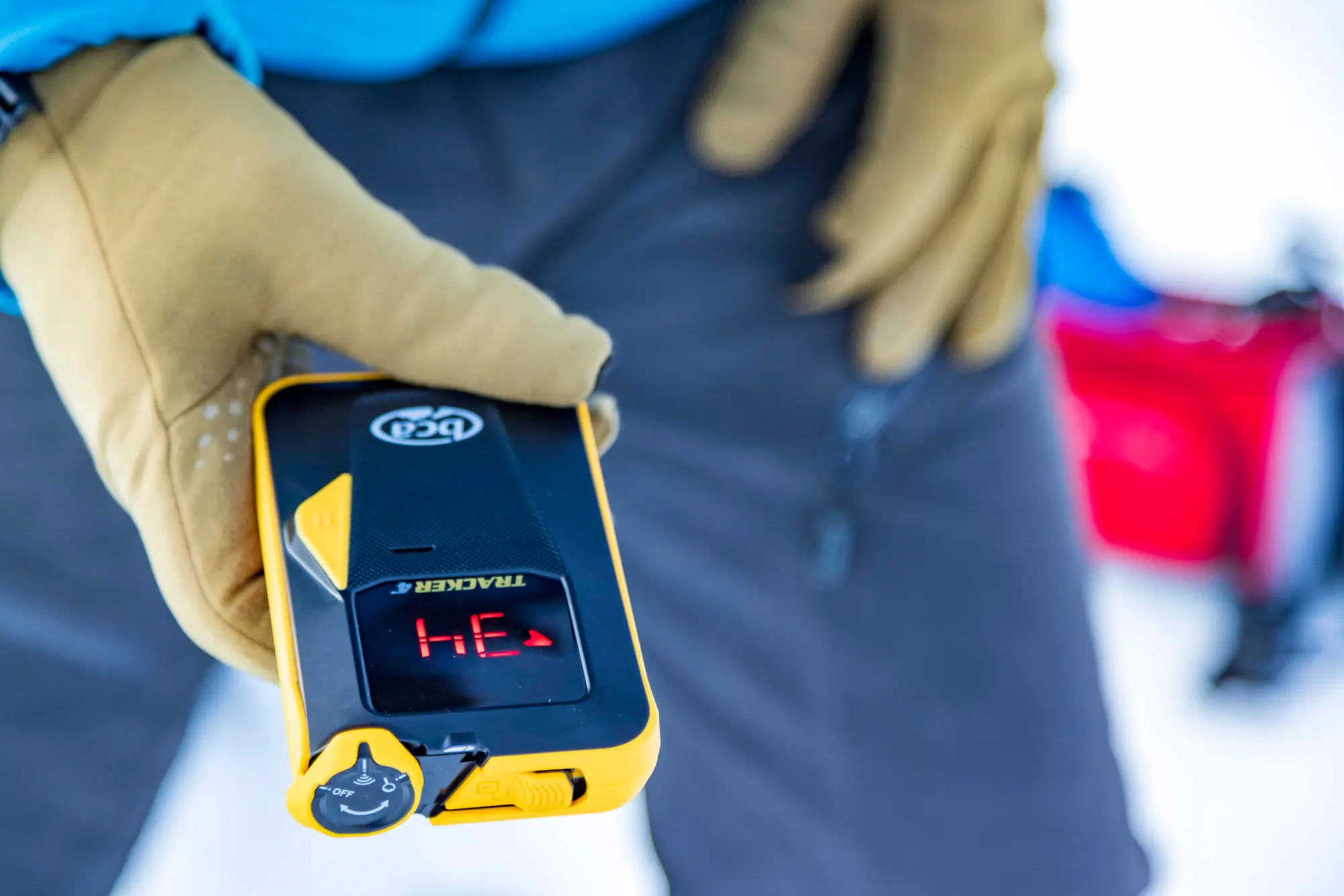



Updateable
We are all used to updates in the digital world, and our beacons are no different. New and improved features, better processing algorithms, battery optimization: all of these things can be improved in software updates.
Many beacons are moving to make these updates very easy to manage through companion apps so your beacon is the best it can be. The Arva, Black Diamond, Pieps, and Ortovox all come with app support. The BCA Tracker 4 can be updated via USB, but only on a PC. The Mammut Barryvox requires a trip to a dealer.
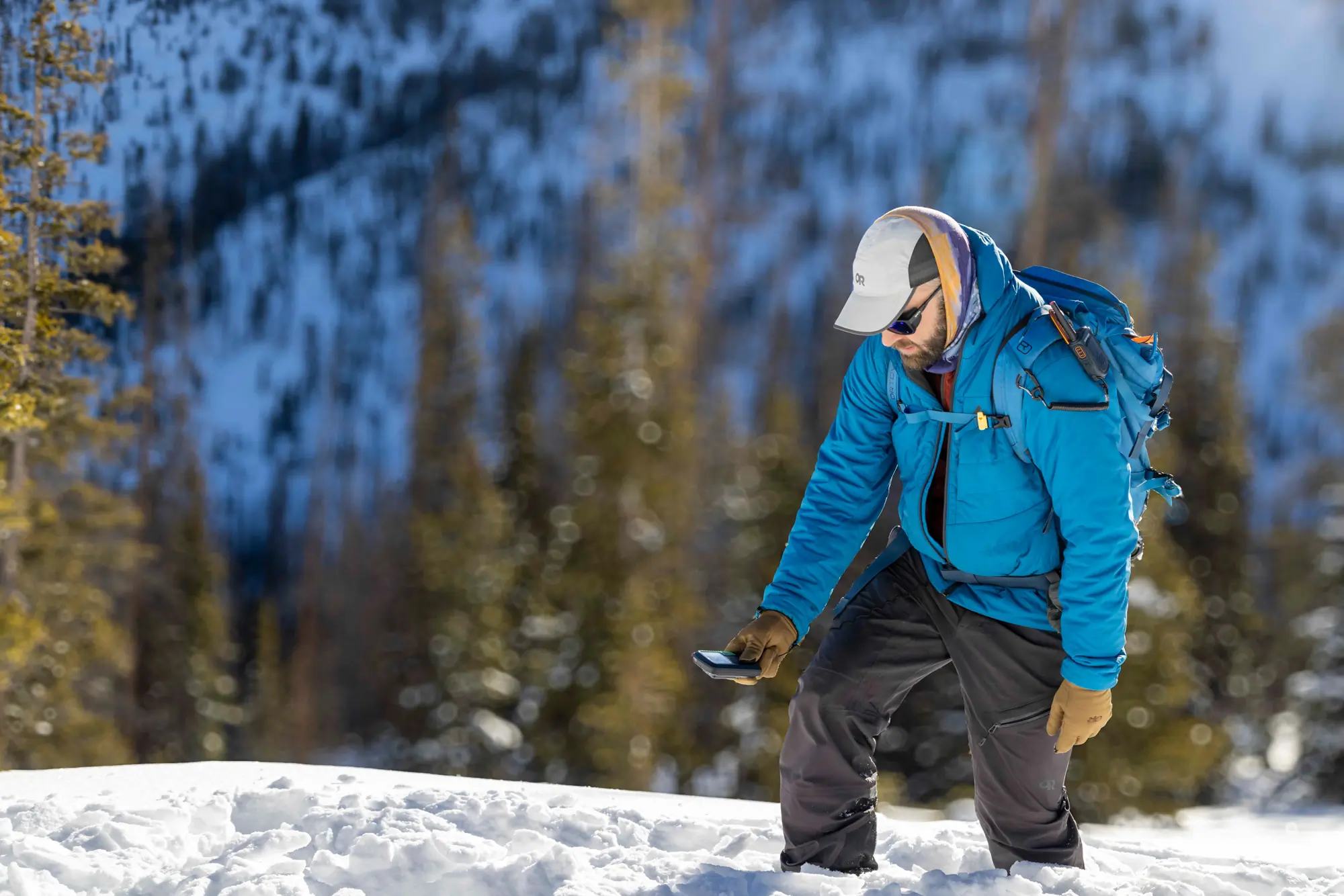



Ease of Use
How intuitive is the beacon for you to use? Is it obvious how to turn it on and off? Do the icons on the screen make sense? In rescue situations where your partner could be buried below the snow, you are their lifeline! This is a huge responsibility. Having a beacon that is easy to switch into search mode, with a screen you can see and directional prompts (visual or audio) you can easily follow, is crucial in a situation where every second counts.
Being calm and level-headed in a rescue situation is critical for your partner’s survival. Using a beacon that provides clear direction could help with that. We really appreciate the on screen prompts of the Arva EVO BT, the Mammut Barryvox, the Pieps Pro IPS, and the Ortovox Diract Voice.
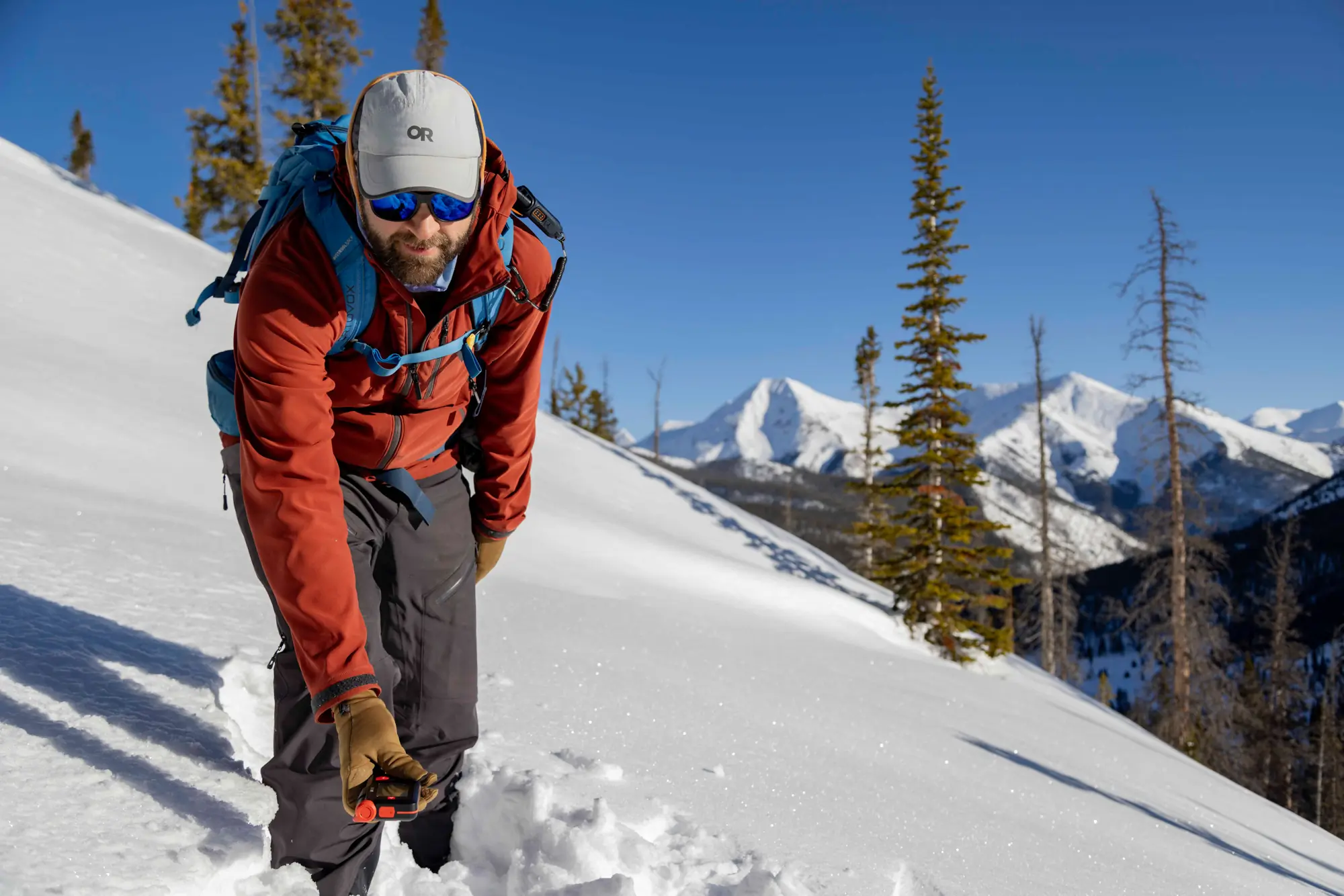



Price & Value
Budget
Avalanche beacons at this level cost less than $300. These are typically considered entry-level beacons because you don’t get all the features of the more expensive tiers. For example, the BCA Tracker S ($299), a lighter, slimmed-down version of the Tracker 4, has fewer bells and whistles — it excludes upgrade software or a motion-sensing auto-revert function.
However, our favorite budget option, the Mammut Barryvox ($299), has a long-range, tenacious signal lock, an easy-to-read screen, and an intuitive user interface, and it feels great in hand. It also doesn’t have upgradable software, but nothing else on the market at this price point functions as well or reliably as it does.
Mid-Tier
For $100 more, you can get our top pick, the Arva EVO BT ($389), which rises above the rest due to its superb performance and ability to acquire a signal from a distance. It also has many features that make it stand out, including its clear, backlit screen with easy-to-see directions, a very useful group check mode, and its reliability in multiple or single rescues.
Premium
Patrollers and guides may want to go with a premium choice due to upgrades in performance and interface. The Mammut Barryvox S2 ($599) and Pieps Pro IPS ($539) avalanche beacons are our top choice for professionals due to their wide range, excellent performance in single and multiple burial scenarios, and comprehensive suite of unique features.
Though the Pieps doesn’t have the extended range of the Arva or even the Mammut (our budget option), it was quicker and more certain in processing signals. Another option in this price range, the Ortovox Diract Voice ($450), has a feature that no other beacon we tested does.
Frequently Asked Questions
Avalanche beacons save lives. Many avalanche fatalities in the United States still occur because the victim was not wearing an avalanche beacon. This makes their partners attempt to find them equivalent to “finding a needle in a haystack.” Its tragic that these deaths still occur when life saving technology is widely available.
A successful rescue is not just dependent on the correct equipment, however. It’s also critical that you and your touring partners are well practiced in the use of your beacons and avalanche rescue so you are ready to respond instantly.
Do all brands of avalanche beacons work together?
Absolutely! All brands of avalanche beacons use the same frequency: 457kHz. This is an international standard. Rest assured, you and your partners will all be sending and receiving on the same frequency. That said, older beacons have a tendency to “drift” from this 457kHz signal standard.
It’s recommended to test for this drifting every year after your beacon hits the five-year mark or so. A beacon that no longer transmits on the correct frequency cannot be found by other beacons. Many manufacturers offer a summer service to check your beacon is functioning properly. Some beacons, like the Arva Evo BT, even have a group check mode that can check other beacons in your group for frequency drift.
A smartphone is an essential item when ski touring. Digital mapping, a camera, trip planning, emergency communications, etc., are all critical for a day out. Even a cellphone in airplane mode can interfere with a beacon. Keep your phone (and any electronic device) at least 8 inches or 20 cm away from a transmitting beacon. In search mode, the distance should be at least 20 inches or 50 cm away, and at least 36 inches or 1 m away if you are sending a signal with the phone, like calling for help.
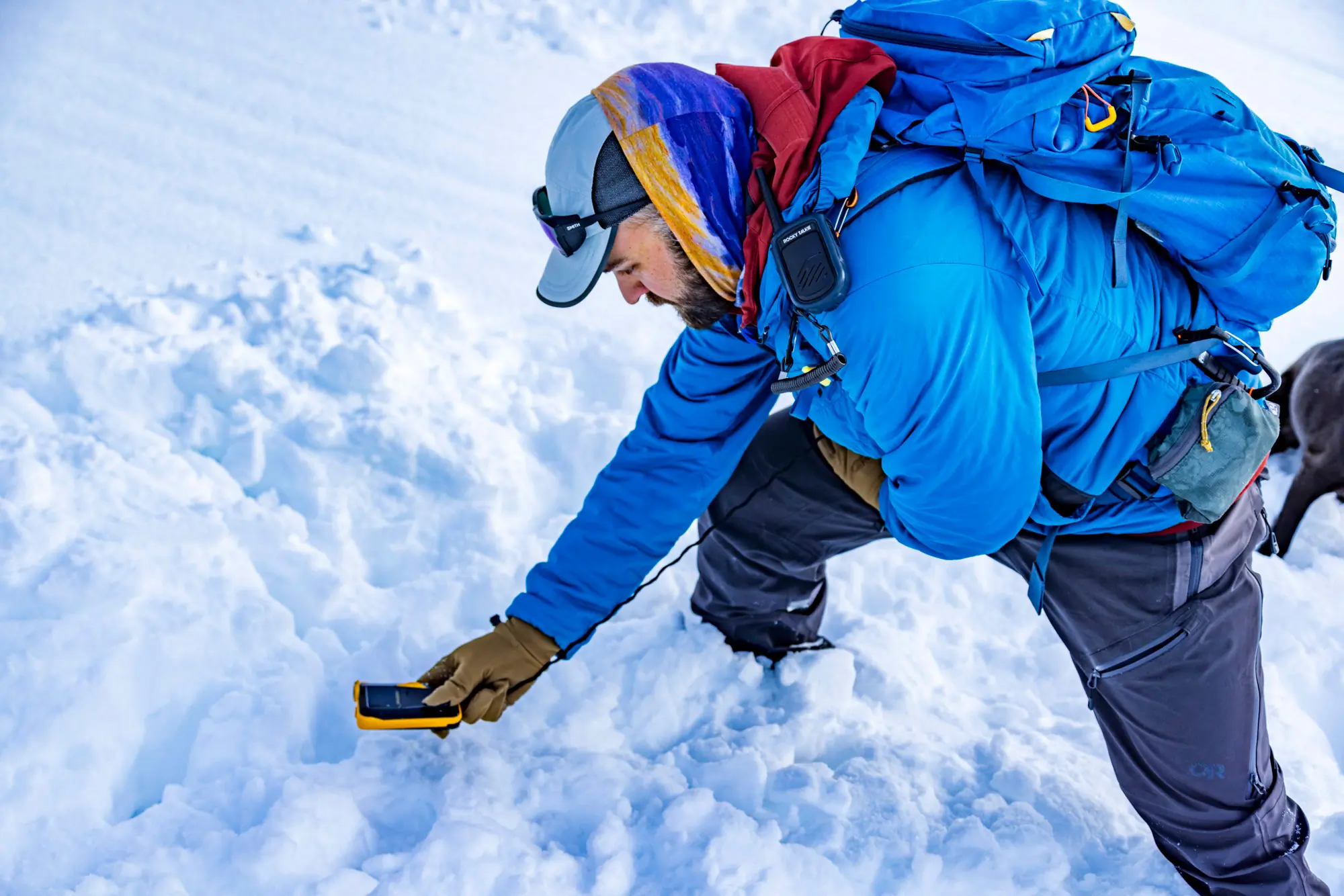



Avalanche beacons send and receive a radio signal at 457 kHz. A beacon can be susceptible to interference from other electronic devices and metal objects if they are too close to your beacon. In general, experts recommend a minimum of 8 inches (20cm) of distance from a beacon in the send/transmit mode, and at least 20 inches (50cm) from a searching beacon. Interference is more likely when searching, and especially at your beacon’s maximum reception range.
This Electromagnetic Interference (EMI) can look like incorrect distance or direction reading, signals that pop up and go away, multiple signals when there shouldn’t be, etc. Many beacon manufacturers are starting to integrate software that senses EMI and will tell the rescuer to remove the source of interference if possible, or shorten search strips.
Black Diamond did extensive work on testing common electronics and how they can interfere with beacons in search mode. Common culprits of EMI include smartphones, radios, smart watches, satellite communication devices, snowmobiles, heated gloves, and even ambient conditions like nearby high voltage power lines can all interfere with your beacon in various degrees of severity.
We would strongly encourage careful consideration and testing of the personal devices you choose to carry into the backcountry, and how they might potentially interfere with a beacon search.
Smartphones can do pretty much anything, but they cannot take the place of a dedicated avalanche beacon. The main reason is that a phone can’t pick up the frequency used in all avalanche beacons, 457kHz. This frequency is a longer wave frequency which is amazing for avalanche burials, as it can penetrate through the snow it’s buried under to send its signal to other beacons searching for it.
At the present time, a smartphone cannot pick up this signal, which over many decades of use has been proven to work effectively. Smartphones have a few notable limitations, mainly battery life in cold environments. Avalanche beacons can send a signal for several hundred hours, and search for at least an hour, in extremely cold temperatures. And even if our phones could pick up the signal, its far more difficult to use a phone screen with wet gloves and cold fingers in a stressful life-or-death situation.
Refer to the manufacturer’s recommendation for specifics on your beacon, but in general, we would suggest upgrading your beacon every 5 to 7 years. Beacon technology is improving every season, and new innovations make rescuers’ jobs easier and can help save lives.
Some manufacturers offer a service to check to make sure an older beacon is still functioning properly, and one important aspect of that is to make sure the frequency a beacon sends a signal on has not “drifted” from the standard 457 kHz. This can happen on older beacons, and if it drifts too far, other beacons will not be able to pick it up as well or potentially at all.
When we respond to an incident, we start by assessing the scene. Can we, as rescuers, enter the scene without hazard from another avalanche? We want to then choose a leader, someone who can delegate tasks accordingly. We check to see how many people are missing and then call for help via phone or satellite messenger.
Search and rescue will take a while to reach your location, so the sooner they can get started, the better! You might need more help with medical issues or help transporting your partner out if they are not able to move. Next, rescuers switch transceivers to search and then determine where to search, usually below the point where the victim was last seen.
We start our coarse search with search strips, a minimum of 40 m zig-zagging down the debris field, leaving 20 m to the sides. This phase is moving fast, trying to get your initial signal. Once we get a signal, we slow down a little, following the direction arrows. A number will show on the beacon, indicating distance in meters. This number should go down as you follow the numbers to the buried beacon.
As we get within 10 m or so, we want to take off our skis/splitboards/snowshoes. This allows all rescuers to move a bit more freely in the area. As the distance gets to 5 m or so, we want to get the beacon right around knee-high, right above the snow surface. This part is where you have to really slow down and allow the beacon to process the signal.
We search for the lowest value, and then mark the snow and start probing from that low point on our beacon. Probe in a spiral pattern outwards. Usually, you will strike the victim, and then you start digging.
This is an avalanche rescue in a very abbreviated summary. Here is a great video breaking down this process.
A dedicated 1-day rescue course, commonly available in the United States, is highly recommended. It’s one thing to read about how to do a rescue; it’s another to have coaching, practice, and build up muscle memory. The more you practice, the more likely you will respond with purpose if your partner were to be buried.


The Best Backcountry Skis of 2025-2026
We tested the best backcountry skis from Atomic, Black Diamond, Salomon, Voile, and more to help you find the best option for your needs and budget.
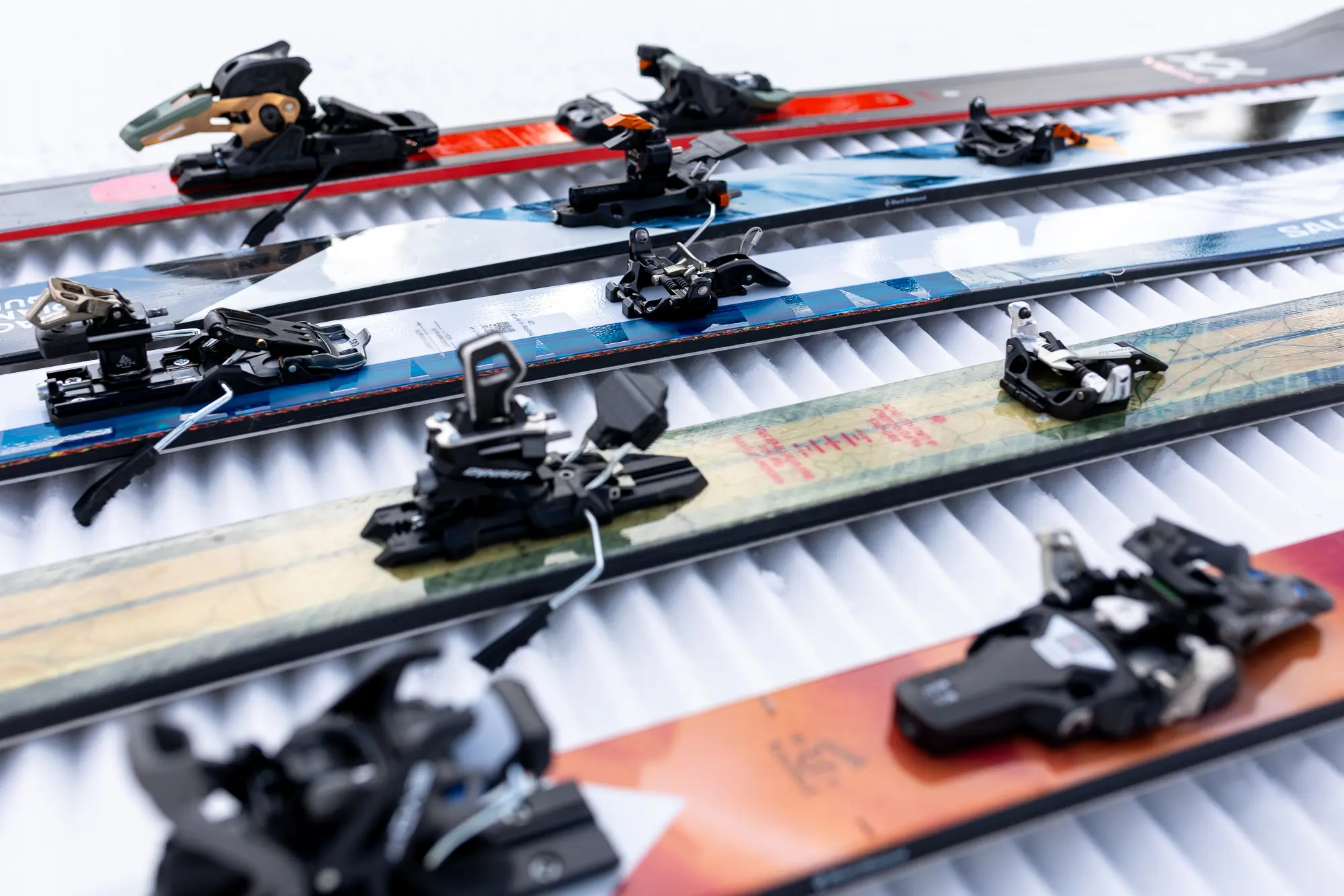

The Best Backcountry Ski Bindings of 2025
We tested the best backcountry ski bindings, including top picks from Salomon, Dynafit, Atomic, ATK, and more.

